
Date: 2021-07-27 11:45:05 CEST, cola version: 1.9.4
Document is loading... 
First the variable is renamed to res_rh.
res_rh = rh
The partition hierarchy and all available functions which can be applied to res_rh object.
res_rh
#> A 'HierarchicalPartition' object with 'ATC:skmeans' method.
#> On a matrix with 11012 rows and 65 columns.
#> Performed in total 1200 partitions.
#> There are 5 groups under the following parameters:
#> - min_samples: 6
#> - mean_silhouette_cutoff: 0.9
#> - min_n_signatures: 115 (signatures are selected based on:)
#> - fdr_cutoff: 0.05
#> - group_diff (scaled values): 0.5
#>
#> Hierarchy of the partition:
#> 0, 65 cols
#> |-- 01, 42 cols, 832 signatures
#> | |-- 011, 16 cols, 85 signatures (c)
#> | |-- 012, 16 cols, 107 signatures (c)
#> | `-- 013, 10 cols (b)
#> `-- 02, 23 cols, 522 signatures
#> |-- 021, 17 cols, 4 signatures (c)
#> `-- 022, 6 cols (b)
#> Stop reason:
#> b) Subgroup had too few columns.
#> c) There were too few signatures.
#>
#> Following methods can be applied to this 'HierarchicalPartition' object:
#> [1] "all_leaves" "all_nodes" "cola_report" "collect_classes"
#> [5] "colnames" "compare_signatures" "dimension_reduction" "functional_enrichment"
#> [9] "get_anno_col" "get_anno" "get_children_nodes" "get_classes"
#> [13] "get_matrix" "get_signatures" "is_leaf_node" "max_depth"
#> [17] "merge_node" "ncol" "node_info" "node_level"
#> [21] "nrow" "rownames" "show" "split_node"
#> [25] "suggest_best_k" "test_to_known_factors" "top_rows_heatmap" "top_rows_overlap"
#>
#> You can get result for a single node by e.g. object["01"]
The call of hierarchical_partition() was:
#> hierarchical_partition(data = mat, anno = anno, cores = 4)
Dimension of the input matrix:
mat = get_matrix(res_rh)
dim(mat)
#> [1] 11012 65
All the methods that were tried:
res_rh@param$combination_method
#> [[1]]
#> [1] "ATC" "skmeans"
The density distribution for each sample is visualized as one column in the following heatmap. The clustering is based on the distance which is the Kolmogorov-Smirnov statistic between two distributions.
library(ComplexHeatmap)
densityHeatmap(mat, top_annotation = HeatmapAnnotation(df = get_anno(res_rh),
col = get_anno_col(res_rh)), ylab = "value", cluster_columns = TRUE, show_column_names = FALSE,
mc.cores = 1)
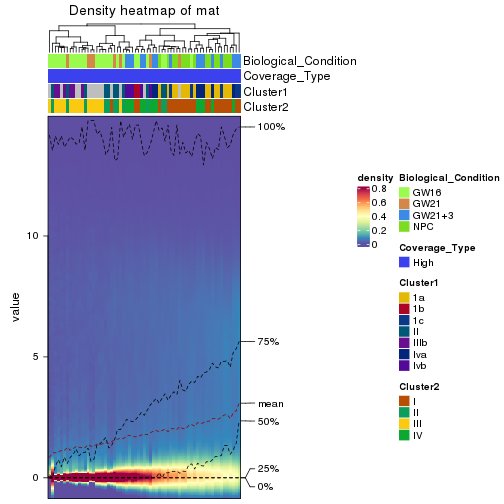
Some values about the hierarchy:
all_nodes(res_rh)
#> [1] "0" "01" "011" "012" "013" "02" "021" "022"
all_leaves(res_rh)
#> [1] "011" "012" "013" "021" "022"
node_info(res_rh)
#> id best_method depth best_k n_columns n_signatures p_signatures is_leaf
#> 1 0 ATC:skmeans 1 2 65 2318 0.210498 FALSE
#> 2 01 ATC:skmeans 2 3 42 832 0.075554 FALSE
#> 3 011 ATC:skmeans 3 2 16 85 0.007719 TRUE
#> 4 012 ATC:skmeans 3 3 16 107 0.009717 TRUE
#> 5 013 not applied 3 NA 10 NA NA TRUE
#> 6 02 ATC:skmeans 2 2 23 522 0.047403 FALSE
#> 7 021 ATC:skmeans 3 2 17 4 0.000363 TRUE
#> 8 022 not applied 3 NA 6 NA NA TRUE
In the output from node_info(), there are the following columns:
id: The node id.best_method: The best method selected.depth: Depth of the node in the hierarchy.best_k: Best number of groups of the partition on that node.n_columns: Number of columns in the submatrix.n_signatures: Number of signatures with the best_k.p_signatures: Proportion of hte signatures in total number of rows in the matrix.is_leaf: Whether the node is a leaf.Labels of nodes are encoded in a special way. The number of digits correspond to the depth of the node in the hierarchy and the value of the digits correspond to the index of the subgroup in the current node, E.g. a label of “012” means the node is the second subgroup of the partition which is the first subgroup of the root node.
Following table shows the best k (number of partitions) for each node in the
partition hierarchy. Clicking on the node name in the table goes to the
corresponding section for the partitioning on that node.
The cola vignette explains the definition of the metrics used for determining the best number of partitions.
suggest_best_k(res_rh)
| Node | Best method | Is leaf | Best k | 1-PAC | Mean silhouette | Concordance | #samples | |
|---|---|---|---|---|---|---|---|---|
| Node0 | ATC:skmeans | 4 | 0.90 | 0.92 | 0.96 | 65 | * | |
| Node01 | ATC:skmeans | 3 | 1.00 | 1.00 | 1.00 | 42 | ** | |
| Node011-leaf | ATC:skmeans | ✓ (c) | 2 | 1.00 | 1.00 | 1.00 | 16 | ** |
| Node012-leaf | ATC:skmeans | ✓ (c) | 3 | 0.95 | 0.98 | 0.99 | 16 | * |
| Node013-leaf | not applied | ✓ (b) | 10 | |||||
| Node02 | ATC:skmeans | 2 | 1.00 | 0.99 | 0.99 | 23 | ** | |
| Node021-leaf | ATC:skmeans | ✓ (c) | 2 | 1.00 | 1.00 | 1.00 | 17 | ** |
| Node022-leaf | not applied | ✓ (b) | 6 |
Stop reason: b) Subgroup had too few columns. c) There were too few signatures.
**: 1-PAC > 0.95, *: 1-PAC > 0.9
The nodes of the hierarchy can be merged by setting the merge_node parameters. Here we
control the hierarchy with the min_n_signatures parameter. The value of min_n_signatures is
from node_info().
collect_classes(res_rh, merge_node = merge_node_param(min_n_signatures = 522))
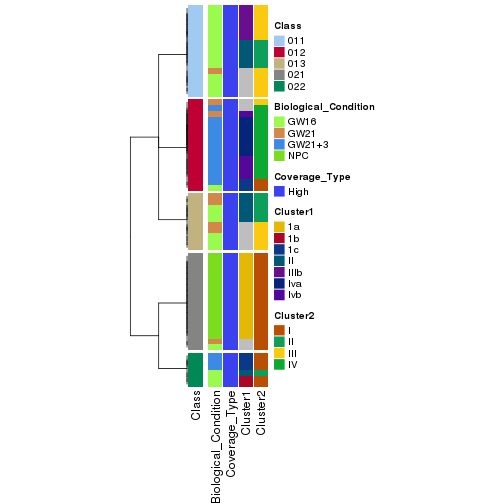
collect_classes(res_rh, merge_node = merge_node_param(min_n_signatures = 832))
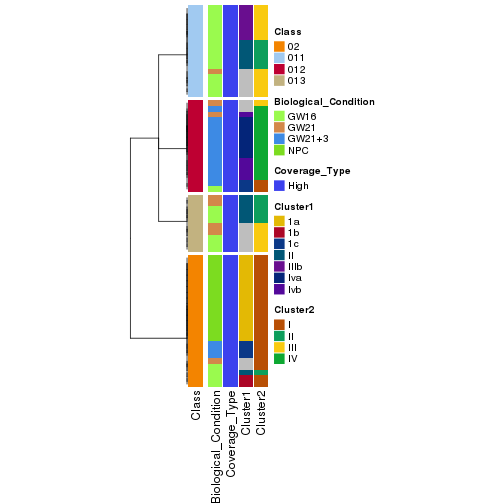
collect_classes(res_rh, merge_node = merge_node_param(min_n_signatures = 2318))
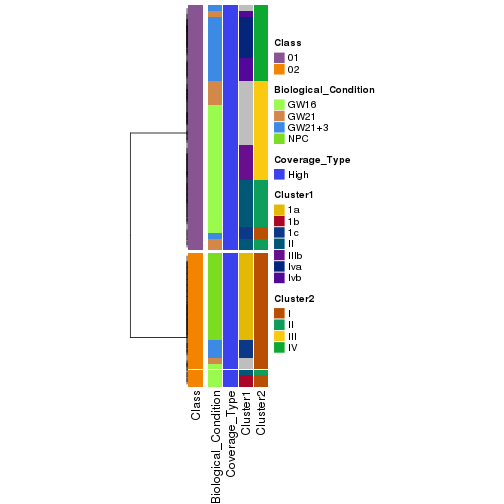
Following shows the table of the partitions (You need to click the show/hide code output link to see it).
get_classes(res_rh, merge_node = merge_node_param(min_n_signatures = 522))
#> SRR1275356 SRR1275251 SRR1275287 SRR1275364 SRR1275269 SRR1275263 SRR1275338 SRR1274117 SRR1274089
#> "011" "013" "012" "011" "021" "013" "013" "021" "021"
#> SRR1274125 SRR1275299 SRR1275277 SRR1275370 SRR1275293 SRR1275348 SRR1275245 SRR1275342 SRR1274131
#> "021" "012" "012" "011" "012" "011" "011" "013" "021"
#> SRR1275346 SRR1275241 SRR1275279 SRR1275297 SRR1275273 SRR1274121 SRR1275336 SRR1274119 SRR1274087
#> "011" "021" "012" "012" "012" "021" "011" "021" "021"
#> SRR1274113 SRR1275267 SRR1275289 SRR1275283 SRR1275360 SRR1275255 SRR1275358 SRR1275352 SRR1275265
#> "021" "012" "012" "022" "011" "013" "013" "022" "012"
#> SRR1275368 SRR1275281 SRR1275362 SRR1275257 SRR1275350 SRR1274129 SRR1274123 SRR1275334 SRR1274085
#> "011" "012" "022" "011" "011" "021" "021" "011" "021"
#> SRR1274111 SRR1275249 SRR1275344 SRR1275243 SRR1275301 SRR1275295 SRR1275271 SRR1274133 SRR1275275
#> "021" "011" "022" "011" "012" "012" "012" "021" "022"
#> SRR1275291 SRR1275247 SRR1275340 SRR1274115 SRR1274127 SRR1275354 SRR1275259 SRR1275253 SRR1275285
#> "022" "012" "013" "021" "021" "011" "013" "011" "012"
#> SRR1275366 SRR1275261
#> "013" "013"
get_classes(res_rh, merge_node = merge_node_param(min_n_signatures = 832))
#> SRR1275356 SRR1275251 SRR1275287 SRR1275364 SRR1275269 SRR1275263 SRR1275338 SRR1274117 SRR1274089
#> "011" "013" "012" "011" "02" "013" "013" "02" "02"
#> SRR1274125 SRR1275299 SRR1275277 SRR1275370 SRR1275293 SRR1275348 SRR1275245 SRR1275342 SRR1274131
#> "02" "012" "012" "011" "012" "011" "011" "013" "02"
#> SRR1275346 SRR1275241 SRR1275279 SRR1275297 SRR1275273 SRR1274121 SRR1275336 SRR1274119 SRR1274087
#> "011" "02" "012" "012" "012" "02" "011" "02" "02"
#> SRR1274113 SRR1275267 SRR1275289 SRR1275283 SRR1275360 SRR1275255 SRR1275358 SRR1275352 SRR1275265
#> "02" "012" "012" "02" "011" "013" "013" "02" "012"
#> SRR1275368 SRR1275281 SRR1275362 SRR1275257 SRR1275350 SRR1274129 SRR1274123 SRR1275334 SRR1274085
#> "011" "012" "02" "011" "011" "02" "02" "011" "02"
#> SRR1274111 SRR1275249 SRR1275344 SRR1275243 SRR1275301 SRR1275295 SRR1275271 SRR1274133 SRR1275275
#> "02" "011" "02" "011" "012" "012" "012" "02" "02"
#> SRR1275291 SRR1275247 SRR1275340 SRR1274115 SRR1274127 SRR1275354 SRR1275259 SRR1275253 SRR1275285
#> "02" "012" "013" "02" "02" "011" "013" "011" "012"
#> SRR1275366 SRR1275261
#> "013" "013"
get_classes(res_rh, merge_node = merge_node_param(min_n_signatures = 2318))
#> SRR1275356 SRR1275251 SRR1275287 SRR1275364 SRR1275269 SRR1275263 SRR1275338 SRR1274117 SRR1274089
#> "01" "01" "01" "01" "02" "01" "01" "02" "02"
#> SRR1274125 SRR1275299 SRR1275277 SRR1275370 SRR1275293 SRR1275348 SRR1275245 SRR1275342 SRR1274131
#> "02" "01" "01" "01" "01" "01" "01" "01" "02"
#> SRR1275346 SRR1275241 SRR1275279 SRR1275297 SRR1275273 SRR1274121 SRR1275336 SRR1274119 SRR1274087
#> "01" "02" "01" "01" "01" "02" "01" "02" "02"
#> SRR1274113 SRR1275267 SRR1275289 SRR1275283 SRR1275360 SRR1275255 SRR1275358 SRR1275352 SRR1275265
#> "02" "01" "01" "02" "01" "01" "01" "02" "01"
#> SRR1275368 SRR1275281 SRR1275362 SRR1275257 SRR1275350 SRR1274129 SRR1274123 SRR1275334 SRR1274085
#> "01" "01" "02" "01" "01" "02" "02" "01" "02"
#> SRR1274111 SRR1275249 SRR1275344 SRR1275243 SRR1275301 SRR1275295 SRR1275271 SRR1274133 SRR1275275
#> "02" "01" "02" "01" "01" "01" "01" "02" "02"
#> SRR1275291 SRR1275247 SRR1275340 SRR1274115 SRR1274127 SRR1275354 SRR1275259 SRR1275253 SRR1275285
#> "02" "01" "01" "02" "02" "01" "01" "01" "01"
#> SRR1275366 SRR1275261
#> "01" "01"
Heatmaps of the top rows:
top_rows_heatmap(res_rh)
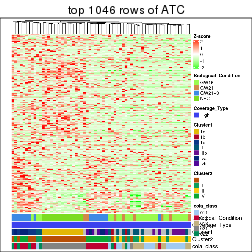
Top rows on each node:
top_rows_overlap(res_rh, method = "upset")
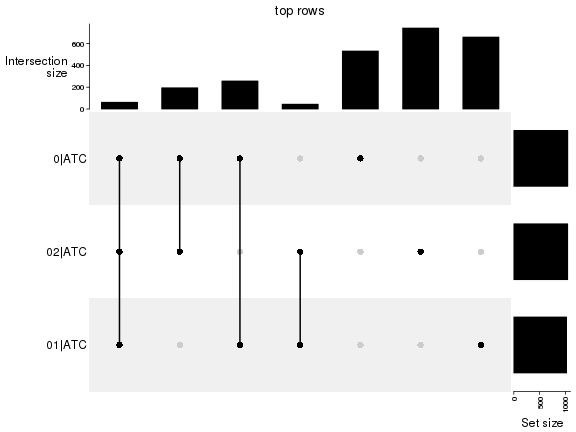
UMAP plot which shows how samples are separated.
par(mfrow = c(1, 2))
dimension_reduction(res_rh, merge_node = merge_node_param(min_n_signatures = 522),
method = "UMAP", top_value_method = "SD", top_n = 1200, scale_rows = FALSE)
dimension_reduction(res_rh, merge_node = merge_node_param(min_n_signatures = 522),
method = "UMAP", top_value_method = "ATC", top_n = 1200, scale_rows = TRUE)
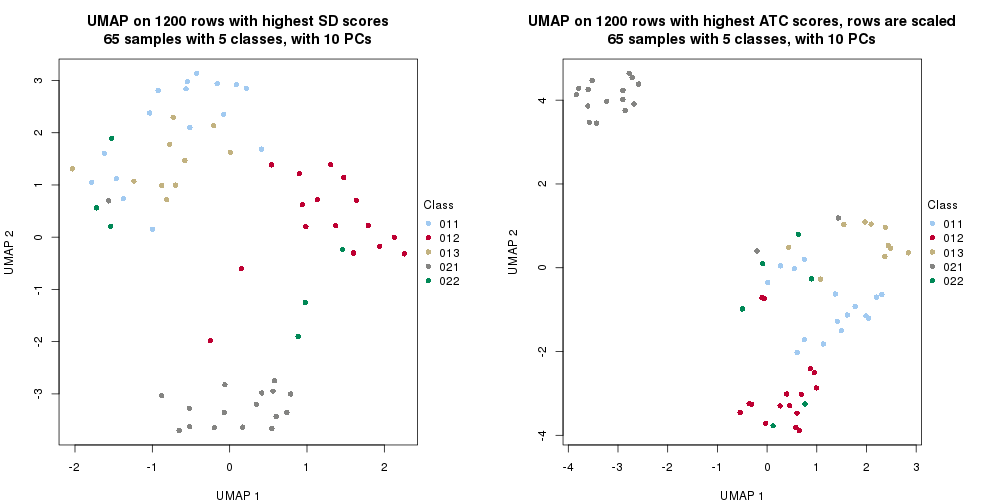
par(mfrow = c(1, 2))
dimension_reduction(res_rh, merge_node = merge_node_param(min_n_signatures = 832),
method = "UMAP", top_value_method = "SD", top_n = 1200, scale_rows = FALSE)
dimension_reduction(res_rh, merge_node = merge_node_param(min_n_signatures = 832),
method = "UMAP", top_value_method = "ATC", top_n = 1200, scale_rows = TRUE)
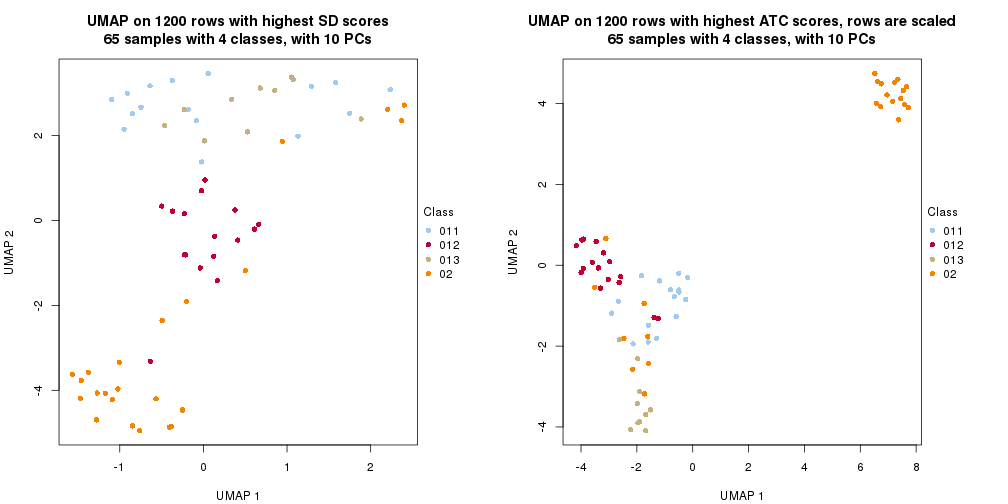
par(mfrow = c(1, 2))
dimension_reduction(res_rh, merge_node = merge_node_param(min_n_signatures = 2318),
method = "UMAP", top_value_method = "SD", top_n = 1200, scale_rows = FALSE)
dimension_reduction(res_rh, merge_node = merge_node_param(min_n_signatures = 2318),
method = "UMAP", top_value_method = "ATC", top_n = 1200, scale_rows = TRUE)
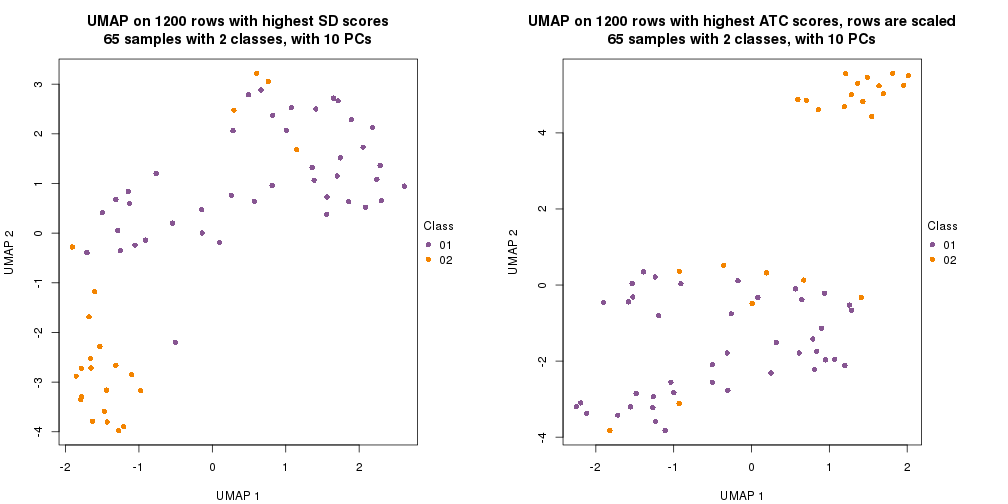
Signatures on the heatmap are the union of all signatures found on every node on the hierarchy. The number of k-means on rows are automatically selected by the function.
get_signatures(res_rh, merge_node = merge_node_param(min_n_signatures = 522))
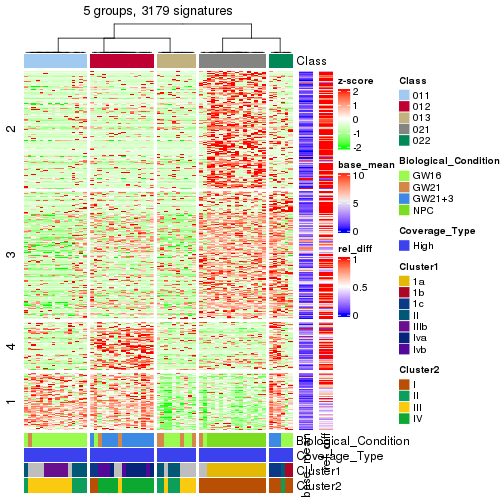
get_signatures(res_rh, merge_node = merge_node_param(min_n_signatures = 832))
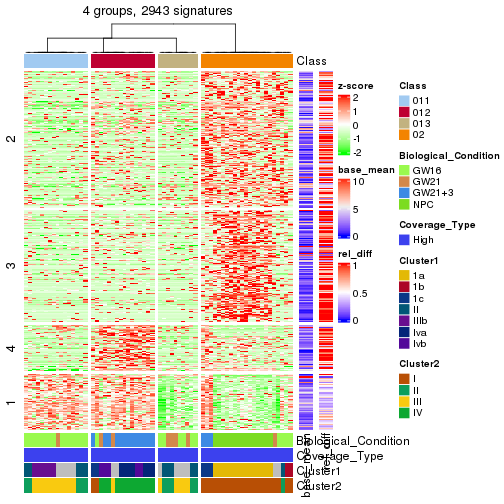
get_signatures(res_rh, merge_node = merge_node_param(min_n_signatures = 2318))
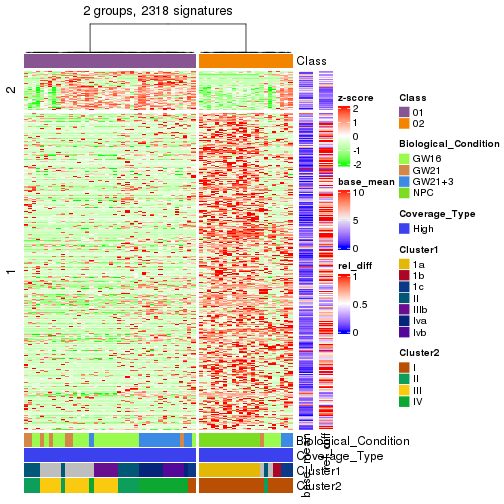
Compare signatures from different nodes:
compare_signatures(res_rh, verbose = FALSE)

If there are too many signatures, top_signatures = ... can be set to only show the
signatures with the highest FDRs. Note it only works on every node and the final signatures
are the union of all signatures of all nodes.
# code only for demonstration
# e.g. to show the top 500 most significant rows on each node.
tb = get_signature(res_rh, top_signatures = 500)
Test correlation between subgroups and known annotations. If the known annotation is numeric, one-way ANOVA test is applied, and if the known annotation is discrete, chi-squared contingency table test is applied.
test_to_known_factors(res_rh, merge_node = merge_node_param(min_n_signatures = 522))
#> Biological_Condition Coverage_Type Cluster1 Cluster2
#> class 4.45e-17 NA 1.38e-18 7.45e-18
test_to_known_factors(res_rh, merge_node = merge_node_param(min_n_signatures = 832))
#> Biological_Condition Coverage_Type Cluster1 Cluster2
#> class 2.79e-14 NA 6.11e-14 3.03e-19
test_to_known_factors(res_rh, merge_node = merge_node_param(min_n_signatures = 2318))
#> Biological_Condition Coverage_Type Cluster1 Cluster2
#> class 8.63e-08 NA 1.61e-07 1.83e-11
Child nodes: Node01 , Node02 .
The object with results only for a single top-value method and a single partitioning method can be extracted as:
res = res_rh["0"]
A summary of res and all the functions that can be applied to it:
res
#> A 'ConsensusPartition' object with k = 2, 3, 4.
#> On a matrix with 10462 rows and 65 columns.
#> Top rows (1046) are extracted by 'ATC' method.
#> Subgroups are detected by 'skmeans' method.
#> Performed in total 150 partitions by row resampling.
#> Best k for subgroups seems to be 4.
#>
#> Following methods can be applied to this 'ConsensusPartition' object:
#> [1] "cola_report" "collect_classes" "collect_plots"
#> [4] "collect_stats" "colnames" "compare_partitions"
#> [7] "compare_signatures" "consensus_heatmap" "dimension_reduction"
#> [10] "functional_enrichment" "get_anno_col" "get_anno"
#> [13] "get_classes" "get_consensus" "get_matrix"
#> [16] "get_membership" "get_param" "get_signatures"
#> [19] "get_stats" "is_best_k" "is_stable_k"
#> [22] "membership_heatmap" "ncol" "nrow"
#> [25] "plot_ecdf" "predict_classes" "rownames"
#> [28] "select_partition_number" "show" "suggest_best_k"
#> [31] "test_to_known_factors" "top_rows_heatmap"
collect_plots() function collects all the plots made from res for all k (number of subgroups)
into one single page to provide an easy and fast comparison between different k.
collect_plots(res)
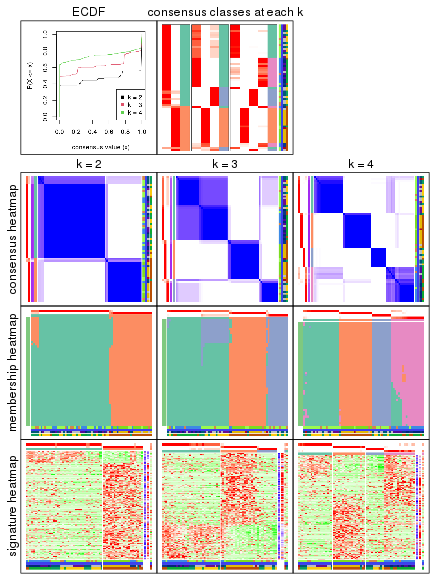
The plots are:
k and the heatmap of
predicted classes for each k.k.k.k.All the plots in panels can be made by individual functions and they are plotted later in this section.
select_partition_number() produces several plots showing different
statistics for choosing “optimized” k. There are following statistics:
k;k, the area increased is defined as \(A_k - A_{k-1}\).The detailed explanations of these statistics can be found in the cola vignette.
Generally speaking, higher 1-PAC score, higher mean silhouette score or higher
concordance corresponds to better partition. Rand index and Jaccard index
measure how similar the current partition is compared to partition with k-1.
If they are too similar, we won't accept k is better than k-1.
select_partition_number(res)
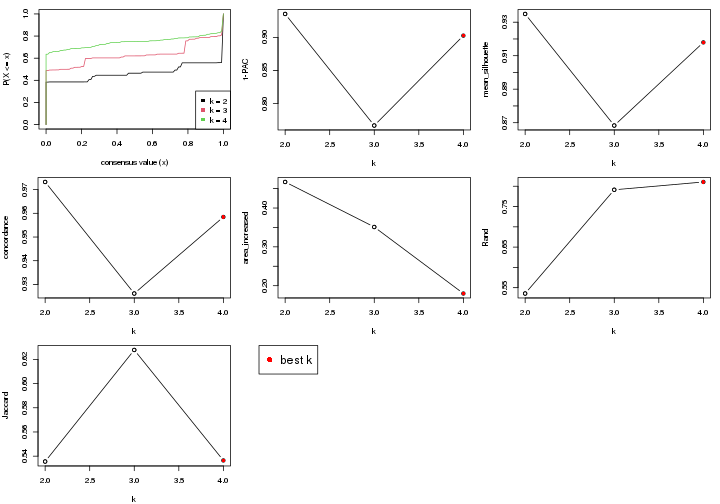
The numeric values for all these statistics can be obtained by get_stats().
get_stats(res)
#> k 1-PAC mean_silhouette concordance area_increased Rand Jaccard
#> 2 2 0.936 0.935 0.973 0.467 0.536 0.536
#> 3 3 0.767 0.868 0.926 0.351 0.791 0.628
#> 4 4 0.903 0.918 0.958 0.180 0.811 0.536
suggest_best_k() suggests the best \(k\) based on these statistics. The rules are as follows:
suggest_best_k(res)
#> [1] 4
#> attr(,"optional")
#> [1] 2
There is also optional best \(k\) = 2 that is worth to check.
Following is the table of the partitions (You need to click the show/hide
code output link to see it). The membership matrix (columns with name p*)
is inferred by
clue::cl_consensus()
function with the SE method. Basically the value in the membership matrix
represents the probability to belong to a certain group. The finall subgroup
label for an item is determined with the group with highest probability it
belongs to.
In get_classes() function, the entropy is calculated from the membership
matrix and the silhouette score is calculated from the consensus matrix.
cbind(get_classes(res, k = 2), get_membership(res, k = 2))
#> class entropy silhouette p1 p2
#> SRR1275356 1 0.000 0.974 1.00 0.00
#> SRR1275251 1 0.000 0.974 1.00 0.00
#> SRR1275287 1 0.000 0.974 1.00 0.00
#> SRR1275364 1 0.000 0.974 1.00 0.00
#> SRR1275269 2 0.000 0.966 0.00 1.00
#> SRR1275263 1 0.855 0.626 0.72 0.28
#> SRR1275338 1 0.795 0.693 0.76 0.24
#> SRR1274117 2 0.000 0.966 0.00 1.00
#> SRR1274089 2 0.000 0.966 0.00 1.00
#> SRR1274125 2 0.000 0.966 0.00 1.00
#> SRR1275299 1 0.000 0.974 1.00 0.00
#> SRR1275277 1 0.000 0.974 1.00 0.00
#> SRR1275370 1 0.000 0.974 1.00 0.00
#> SRR1275293 1 0.000 0.974 1.00 0.00
#> SRR1275348 1 0.000 0.974 1.00 0.00
#> SRR1275245 1 0.000 0.974 1.00 0.00
#> SRR1275342 1 0.000 0.974 1.00 0.00
#> SRR1274131 2 0.000 0.966 0.00 1.00
#> SRR1275346 1 0.000 0.974 1.00 0.00
#> SRR1275241 2 0.000 0.966 0.00 1.00
#> SRR1275279 1 0.000 0.974 1.00 0.00
#> SRR1275297 1 0.000 0.974 1.00 0.00
#> SRR1275273 1 0.000 0.974 1.00 0.00
#> SRR1274121 2 0.000 0.966 0.00 1.00
#> SRR1275336 1 0.000 0.974 1.00 0.00
#> SRR1274119 2 0.000 0.966 0.00 1.00
#> SRR1274087 2 0.000 0.966 0.00 1.00
#> SRR1274113 2 0.000 0.966 0.00 1.00
#> SRR1275267 1 0.000 0.974 1.00 0.00
#> SRR1275289 1 0.000 0.974 1.00 0.00
#> SRR1275283 2 0.000 0.966 0.00 1.00
#> SRR1275360 1 0.000 0.974 1.00 0.00
#> SRR1275255 1 0.000 0.974 1.00 0.00
#> SRR1275358 1 0.795 0.693 0.76 0.24
#> SRR1275352 2 0.000 0.966 0.00 1.00
#> SRR1275265 1 0.000 0.974 1.00 0.00
#> SRR1275368 1 0.000 0.974 1.00 0.00
#> SRR1275281 1 0.000 0.974 1.00 0.00
#> SRR1275362 2 0.000 0.966 0.00 1.00
#> SRR1275257 1 0.000 0.974 1.00 0.00
#> SRR1275350 1 0.000 0.974 1.00 0.00
#> SRR1274129 2 0.000 0.966 0.00 1.00
#> SRR1274123 2 0.000 0.966 0.00 1.00
#> SRR1275334 1 0.000 0.974 1.00 0.00
#> SRR1274085 2 0.000 0.966 0.00 1.00
#> SRR1274111 2 0.000 0.966 0.00 1.00
#> SRR1275249 1 0.000 0.974 1.00 0.00
#> SRR1275344 2 0.995 0.170 0.46 0.54
#> SRR1275243 1 0.000 0.974 1.00 0.00
#> SRR1275301 1 0.000 0.974 1.00 0.00
#> SRR1275295 1 0.000 0.974 1.00 0.00
#> SRR1275271 1 0.000 0.974 1.00 0.00
#> SRR1274133 2 0.000 0.966 0.00 1.00
#> SRR1275275 2 0.827 0.643 0.26 0.74
#> SRR1275291 2 0.000 0.966 0.00 1.00
#> SRR1275247 1 0.000 0.974 1.00 0.00
#> SRR1275340 1 0.000 0.974 1.00 0.00
#> SRR1274115 2 0.000 0.966 0.00 1.00
#> SRR1274127 2 0.000 0.966 0.00 1.00
#> SRR1275354 1 0.000 0.974 1.00 0.00
#> SRR1275259 1 0.000 0.974 1.00 0.00
#> SRR1275253 1 0.000 0.974 1.00 0.00
#> SRR1275285 1 0.000 0.974 1.00 0.00
#> SRR1275366 1 0.000 0.974 1.00 0.00
#> SRR1275261 1 0.827 0.660 0.74 0.26
cbind(get_classes(res, k = 3), get_membership(res, k = 3))
#> class entropy silhouette p1 p2 p3
#> SRR1275356 1 0.4796 0.826 0.78 0.00 0.22
#> SRR1275251 3 0.0000 0.923 0.00 0.00 1.00
#> SRR1275287 1 0.0000 0.866 1.00 0.00 0.00
#> SRR1275364 1 0.4796 0.826 0.78 0.00 0.22
#> SRR1275269 2 0.0000 0.978 0.00 1.00 0.00
#> SRR1275263 3 0.0000 0.923 0.00 0.00 1.00
#> SRR1275338 3 0.0000 0.923 0.00 0.00 1.00
#> SRR1274117 2 0.0000 0.978 0.00 1.00 0.00
#> SRR1274089 2 0.0000 0.978 0.00 1.00 0.00
#> SRR1274125 2 0.0000 0.978 0.00 1.00 0.00
#> SRR1275299 1 0.0000 0.866 1.00 0.00 0.00
#> SRR1275277 1 0.0000 0.866 1.00 0.00 0.00
#> SRR1275370 1 0.4796 0.826 0.78 0.00 0.22
#> SRR1275293 1 0.0000 0.866 1.00 0.00 0.00
#> SRR1275348 1 0.2537 0.856 0.92 0.00 0.08
#> SRR1275245 1 0.4796 0.826 0.78 0.00 0.22
#> SRR1275342 3 0.0000 0.923 0.00 0.00 1.00
#> SRR1274131 2 0.0000 0.978 0.00 1.00 0.00
#> SRR1275346 1 0.5216 0.784 0.74 0.00 0.26
#> SRR1275241 3 0.4796 0.619 0.00 0.22 0.78
#> SRR1275279 1 0.0000 0.866 1.00 0.00 0.00
#> SRR1275297 1 0.0000 0.866 1.00 0.00 0.00
#> SRR1275273 1 0.0000 0.866 1.00 0.00 0.00
#> SRR1274121 2 0.0000 0.978 0.00 1.00 0.00
#> SRR1275336 1 0.4796 0.826 0.78 0.00 0.22
#> SRR1274119 2 0.0000 0.978 0.00 1.00 0.00
#> SRR1274087 2 0.0000 0.978 0.00 1.00 0.00
#> SRR1274113 2 0.0000 0.978 0.00 1.00 0.00
#> SRR1275267 1 0.0892 0.864 0.98 0.00 0.02
#> SRR1275289 1 0.0000 0.866 1.00 0.00 0.00
#> SRR1275283 2 0.4002 0.810 0.16 0.84 0.00
#> SRR1275360 1 0.4796 0.826 0.78 0.00 0.22
#> SRR1275255 3 0.0000 0.923 0.00 0.00 1.00
#> SRR1275358 3 0.0000 0.923 0.00 0.00 1.00
#> SRR1275352 2 0.0000 0.978 0.00 1.00 0.00
#> SRR1275265 1 0.0000 0.866 1.00 0.00 0.00
#> SRR1275368 1 0.4796 0.826 0.78 0.00 0.22
#> SRR1275281 1 0.0000 0.866 1.00 0.00 0.00
#> SRR1275362 2 0.0000 0.978 0.00 1.00 0.00
#> SRR1275257 1 0.4796 0.826 0.78 0.00 0.22
#> SRR1275350 1 0.6244 0.453 0.56 0.00 0.44
#> SRR1274129 2 0.0000 0.978 0.00 1.00 0.00
#> SRR1274123 2 0.0000 0.978 0.00 1.00 0.00
#> SRR1275334 1 0.4796 0.826 0.78 0.00 0.22
#> SRR1274085 2 0.0000 0.978 0.00 1.00 0.00
#> SRR1274111 2 0.0000 0.978 0.00 1.00 0.00
#> SRR1275249 1 0.4796 0.826 0.78 0.00 0.22
#> SRR1275344 3 0.9110 -0.150 0.42 0.14 0.44
#> SRR1275243 1 0.4796 0.826 0.78 0.00 0.22
#> SRR1275301 1 0.0000 0.866 1.00 0.00 0.00
#> SRR1275295 1 0.0000 0.866 1.00 0.00 0.00
#> SRR1275271 1 0.0000 0.866 1.00 0.00 0.00
#> SRR1274133 2 0.0000 0.978 0.00 1.00 0.00
#> SRR1275275 1 0.0000 0.866 1.00 0.00 0.00
#> SRR1275291 2 0.4555 0.761 0.20 0.80 0.00
#> SRR1275247 1 0.0000 0.866 1.00 0.00 0.00
#> SRR1275340 3 0.0000 0.923 0.00 0.00 1.00
#> SRR1274115 2 0.0000 0.978 0.00 1.00 0.00
#> SRR1274127 2 0.0000 0.978 0.00 1.00 0.00
#> SRR1275354 1 0.4796 0.826 0.78 0.00 0.22
#> SRR1275259 3 0.0000 0.923 0.00 0.00 1.00
#> SRR1275253 1 0.4796 0.826 0.78 0.00 0.22
#> SRR1275285 1 0.0000 0.866 1.00 0.00 0.00
#> SRR1275366 3 0.0000 0.923 0.00 0.00 1.00
#> SRR1275261 3 0.0000 0.923 0.00 0.00 1.00
cbind(get_classes(res, k = 4), get_membership(res, k = 4))
#> class entropy silhouette p1 p2 p3 p4
#> SRR1275356 1 0.0000 0.977 1.00 0.00 0.00 0.00
#> SRR1275251 3 0.0000 1.000 0.00 0.00 1.00 0.00
#> SRR1275287 4 0.0000 0.847 0.00 0.00 0.00 1.00
#> SRR1275364 1 0.0000 0.977 1.00 0.00 0.00 0.00
#> SRR1275269 2 0.0000 0.994 0.00 1.00 0.00 0.00
#> SRR1275263 3 0.0000 1.000 0.00 0.00 1.00 0.00
#> SRR1275338 3 0.0000 1.000 0.00 0.00 1.00 0.00
#> SRR1274117 2 0.0000 0.994 0.00 1.00 0.00 0.00
#> SRR1274089 2 0.0000 0.994 0.00 1.00 0.00 0.00
#> SRR1274125 2 0.0000 0.994 0.00 1.00 0.00 0.00
#> SRR1275299 4 0.0000 0.847 0.00 0.00 0.00 1.00
#> SRR1275277 4 0.0000 0.847 0.00 0.00 0.00 1.00
#> SRR1275370 1 0.0000 0.977 1.00 0.00 0.00 0.00
#> SRR1275293 4 0.4406 0.672 0.30 0.00 0.00 0.70
#> SRR1275348 1 0.3610 0.735 0.80 0.00 0.00 0.20
#> SRR1275245 1 0.0000 0.977 1.00 0.00 0.00 0.00
#> SRR1275342 3 0.0000 1.000 0.00 0.00 1.00 0.00
#> SRR1274131 2 0.0000 0.994 0.00 1.00 0.00 0.00
#> SRR1275346 1 0.0000 0.977 1.00 0.00 0.00 0.00
#> SRR1275241 3 0.0000 1.000 0.00 0.00 1.00 0.00
#> SRR1275279 4 0.0000 0.847 0.00 0.00 0.00 1.00
#> SRR1275297 4 0.4134 0.713 0.26 0.00 0.00 0.74
#> SRR1275273 4 0.4624 0.618 0.34 0.00 0.00 0.66
#> SRR1274121 2 0.0000 0.994 0.00 1.00 0.00 0.00
#> SRR1275336 1 0.0000 0.977 1.00 0.00 0.00 0.00
#> SRR1274119 2 0.0000 0.994 0.00 1.00 0.00 0.00
#> SRR1274087 2 0.0000 0.994 0.00 1.00 0.00 0.00
#> SRR1274113 2 0.0000 0.994 0.00 1.00 0.00 0.00
#> SRR1275267 1 0.0000 0.977 1.00 0.00 0.00 0.00
#> SRR1275289 4 0.4907 0.461 0.42 0.00 0.00 0.58
#> SRR1275283 4 0.2921 0.739 0.00 0.14 0.00 0.86
#> SRR1275360 1 0.0000 0.977 1.00 0.00 0.00 0.00
#> SRR1275255 3 0.0000 1.000 0.00 0.00 1.00 0.00
#> SRR1275358 3 0.0000 1.000 0.00 0.00 1.00 0.00
#> SRR1275352 2 0.2345 0.889 0.00 0.90 0.00 0.10
#> SRR1275265 4 0.4277 0.695 0.28 0.00 0.00 0.72
#> SRR1275368 1 0.0000 0.977 1.00 0.00 0.00 0.00
#> SRR1275281 4 0.0000 0.847 0.00 0.00 0.00 1.00
#> SRR1275362 2 0.0000 0.994 0.00 1.00 0.00 0.00
#> SRR1275257 1 0.0000 0.977 1.00 0.00 0.00 0.00
#> SRR1275350 1 0.0707 0.960 0.98 0.00 0.02 0.00
#> SRR1274129 2 0.0000 0.994 0.00 1.00 0.00 0.00
#> SRR1274123 2 0.0000 0.994 0.00 1.00 0.00 0.00
#> SRR1275334 1 0.0000 0.977 1.00 0.00 0.00 0.00
#> SRR1274085 2 0.0000 0.994 0.00 1.00 0.00 0.00
#> SRR1274111 2 0.0000 0.994 0.00 1.00 0.00 0.00
#> SRR1275249 1 0.0000 0.977 1.00 0.00 0.00 0.00
#> SRR1275344 1 0.3335 0.836 0.86 0.00 0.02 0.12
#> SRR1275243 1 0.0707 0.959 0.98 0.00 0.00 0.02
#> SRR1275301 4 0.4713 0.585 0.36 0.00 0.00 0.64
#> SRR1275295 4 0.1211 0.837 0.04 0.00 0.00 0.96
#> SRR1275271 4 0.0000 0.847 0.00 0.00 0.00 1.00
#> SRR1274133 2 0.0000 0.994 0.00 1.00 0.00 0.00
#> SRR1275275 4 0.0000 0.847 0.00 0.00 0.00 1.00
#> SRR1275291 4 0.2011 0.794 0.00 0.08 0.00 0.92
#> SRR1275247 4 0.0000 0.847 0.00 0.00 0.00 1.00
#> SRR1275340 3 0.0000 1.000 0.00 0.00 1.00 0.00
#> SRR1274115 2 0.0000 0.994 0.00 1.00 0.00 0.00
#> SRR1274127 2 0.0000 0.994 0.00 1.00 0.00 0.00
#> SRR1275354 1 0.0000 0.977 1.00 0.00 0.00 0.00
#> SRR1275259 3 0.0000 1.000 0.00 0.00 1.00 0.00
#> SRR1275253 1 0.0000 0.977 1.00 0.00 0.00 0.00
#> SRR1275285 4 0.0000 0.847 0.00 0.00 0.00 1.00
#> SRR1275366 1 0.0000 0.977 1.00 0.00 0.00 0.00
#> SRR1275261 3 0.0000 1.000 0.00 0.00 1.00 0.00
Heatmaps for the consensus matrix. It visualizes the probability of two samples to be in a same group.
consensus_heatmap(res, k = 2)
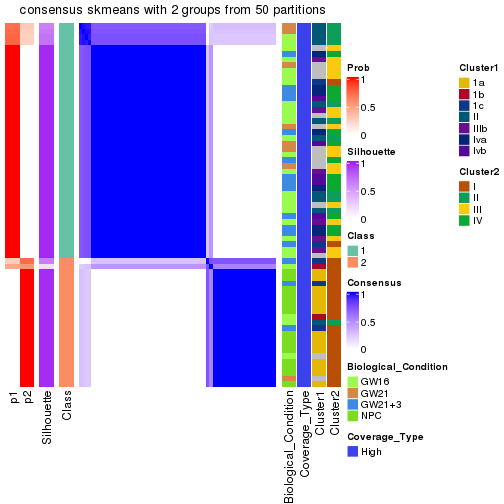
consensus_heatmap(res, k = 3)

consensus_heatmap(res, k = 4)
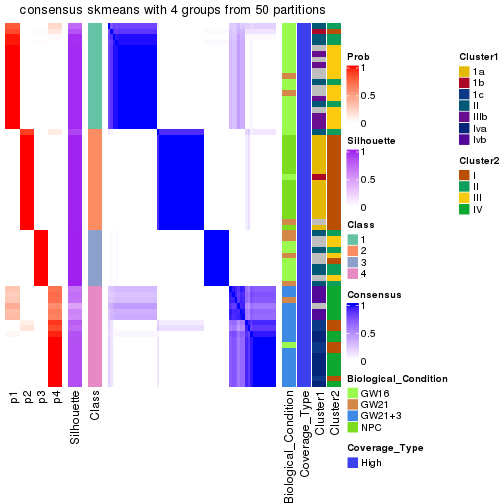
Heatmaps for the membership of samples in all partitions to see how consistent they are:
membership_heatmap(res, k = 2)
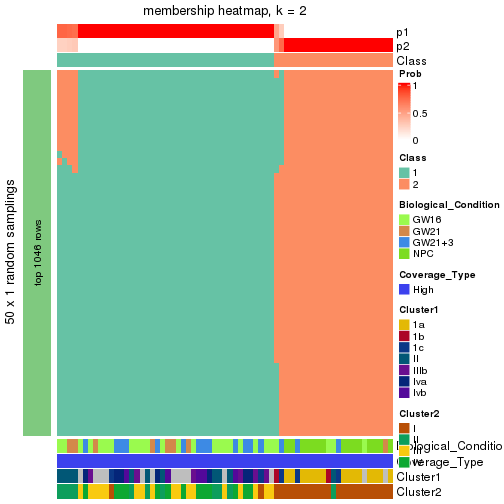
membership_heatmap(res, k = 3)
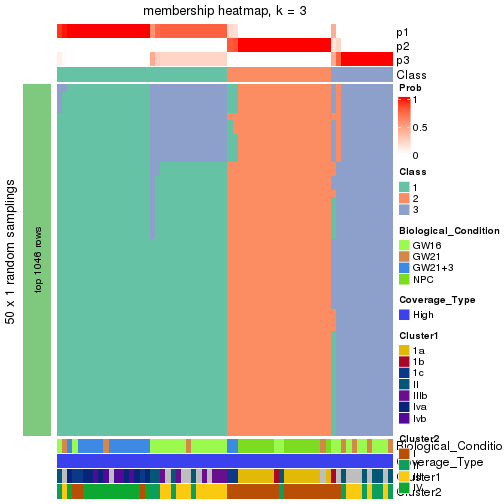
membership_heatmap(res, k = 4)
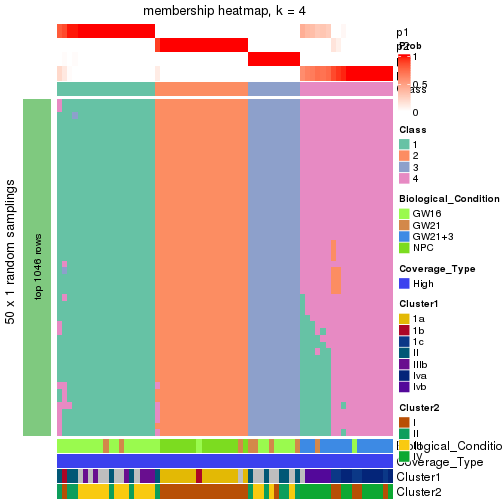
As soon as the classes for columns are determined, the signatures that are significantly different between subgroups can be looked for. Following are the heatmaps for signatures.
Signature heatmaps where rows are scaled:
Signature heatmaps where rows are not scaled:
get_signatures(res, k = 2, scale_rows = FALSE)
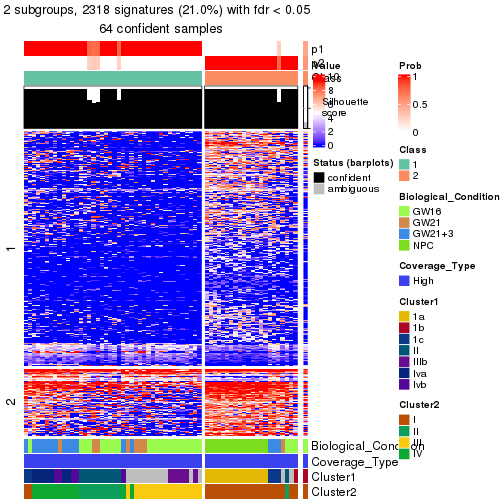
get_signatures(res, k = 3, scale_rows = FALSE)
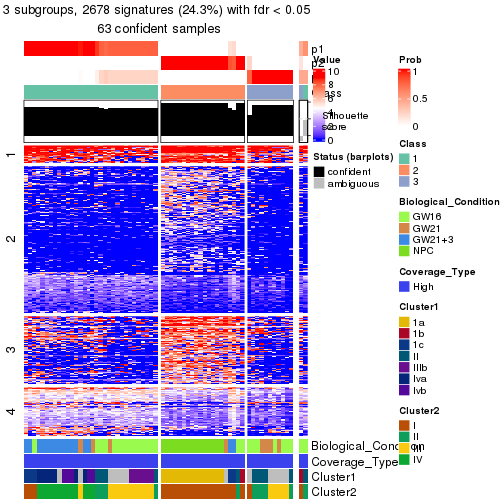
get_signatures(res, k = 4, scale_rows = FALSE)
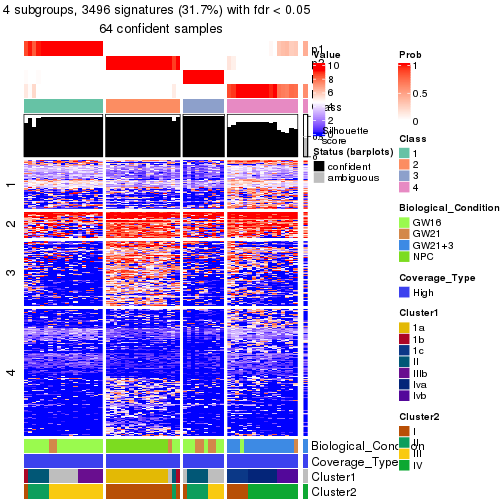
Compare the overlap of signatures from different k:
compare_signatures(res)

get_signature() returns a data frame invisibly. To get the list of signatures, the function
call should be assigned to a variable explicitly. In following code, if plot argument is set
to FALSE, no heatmap is plotted while only the differential analysis is performed.
# code only for demonstration
tb = get_signature(res, k = ..., plot = FALSE)
An example of the output of tb is:
#> which_row fdr mean_1 mean_2 scaled_mean_1 scaled_mean_2 km
#> 1 38 0.042760348 8.373488 9.131774 -0.5533452 0.5164555 1
#> 2 40 0.018707592 7.106213 8.469186 -0.6173731 0.5762149 1
#> 3 55 0.019134737 10.221463 11.207825 -0.6159697 0.5749050 1
#> 4 59 0.006059896 5.921854 7.869574 -0.6899429 0.6439467 1
#> 5 60 0.018055526 8.928898 10.211722 -0.6204761 0.5791110 1
#> 6 98 0.009384629 15.714769 14.887706 0.6635654 -0.6193277 2
...
The columns in tb are:
which_row: row indices corresponding to the input matrix.fdr: FDR for the differential test. mean_x: The mean value in group x.scaled_mean_x: The mean value in group x after rows are scaled.km: Row groups if k-means clustering is applied to rows (which is done by automatically selecting number of clusters).If there are too many signatures, top_signatures = ... can be set to only show the
signatures with the highest FDRs:
# code only for demonstration
# e.g. to show the top 500 most significant rows
tb = get_signature(res, k = ..., top_signatures = 500)
If the signatures are defined as these which are uniquely high in current group, diff_method argument
can be set to "uniquely_high_in_one_group":
# code only for demonstration
tb = get_signature(res, k = ..., diff_method = "uniquely_high_in_one_group")
UMAP plot which shows how samples are separated.
dimension_reduction(res, k = 2, method = "UMAP")
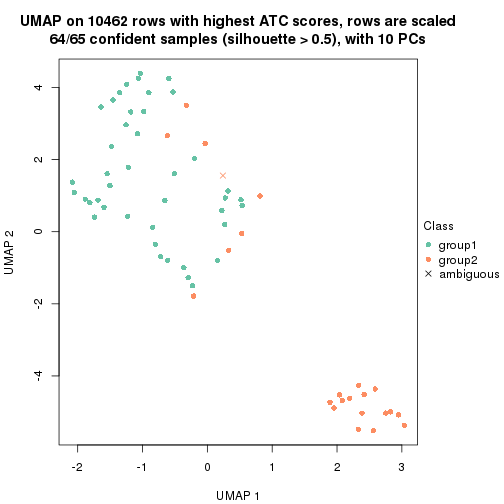
dimension_reduction(res, k = 3, method = "UMAP")
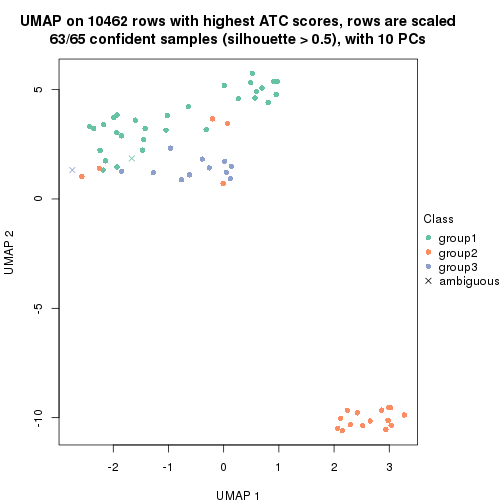
dimension_reduction(res, k = 4, method = "UMAP")
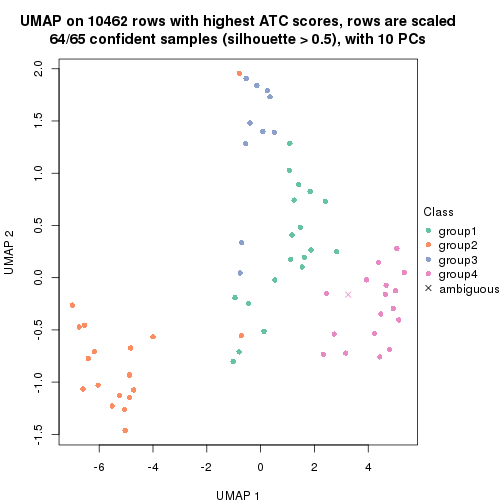
Following heatmap shows how subgroups are split when increasing k:
collect_classes(res)
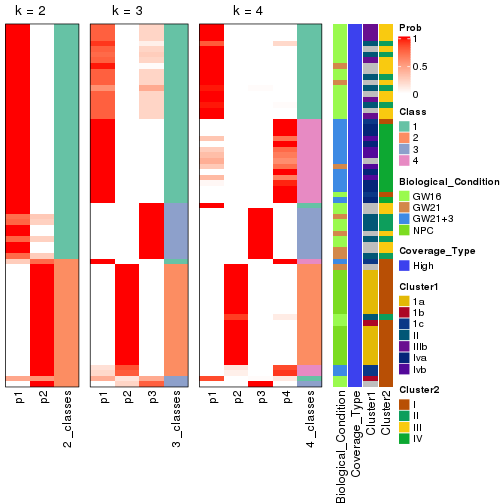
Test correlation between subgroups and known annotations. If the known annotation is numeric, one-way ANOVA test is applied, and if the known annotation is discrete, chi-squared contingency table test is applied.
test_to_known_factors(res)
#> n_sample Biological_Condition(p-value) Coverage_Type(p-value) Cluster1(p-value)
#> ATC:skmeans 64 3.41e-08 NA 2.63e-07
#> ATC:skmeans 63 7.75e-10 NA 1.47e-08
#> ATC:skmeans 64 3.42e-19 NA 1.03e-14
#> Cluster2(p-value) k
#> ATC:skmeans 3.18e-11 2
#> ATC:skmeans 3.00e-10 3
#> ATC:skmeans 1.38e-15 4
If matrix rows can be associated to genes, consider to use functional_enrichment(res,
...) to perform function enrichment for the signature genes. See this vignette for more detailed explanations.
Parent node: Node0. Child nodes: Node011-leaf , Node012-leaf , Node013-leaf , Node021-leaf , Node022-leaf .
The object with results only for a single top-value method and a single partitioning method can be extracted as:
res = res_rh["01"]
A summary of res and all the functions that can be applied to it:
res
#> A 'ConsensusPartition' object with k = 2, 3, 4.
#> On a matrix with 10397 rows and 42 columns.
#> Top rows (1023) are extracted by 'ATC' method.
#> Subgroups are detected by 'skmeans' method.
#> Performed in total 150 partitions by row resampling.
#> Best k for subgroups seems to be 3.
#>
#> Following methods can be applied to this 'ConsensusPartition' object:
#> [1] "cola_report" "collect_classes" "collect_plots"
#> [4] "collect_stats" "colnames" "compare_partitions"
#> [7] "compare_signatures" "consensus_heatmap" "dimension_reduction"
#> [10] "functional_enrichment" "get_anno_col" "get_anno"
#> [13] "get_classes" "get_consensus" "get_matrix"
#> [16] "get_membership" "get_param" "get_signatures"
#> [19] "get_stats" "is_best_k" "is_stable_k"
#> [22] "membership_heatmap" "ncol" "nrow"
#> [25] "plot_ecdf" "predict_classes" "rownames"
#> [28] "select_partition_number" "show" "suggest_best_k"
#> [31] "test_to_known_factors" "top_rows_heatmap"
collect_plots() function collects all the plots made from res for all k (number of subgroups)
into one single page to provide an easy and fast comparison between different k.
collect_plots(res)
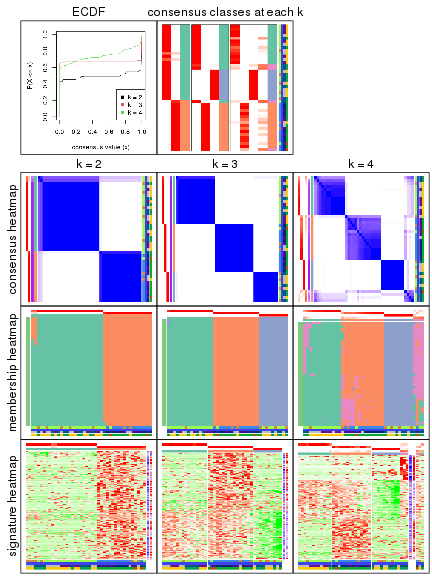
The plots are:
k and the heatmap of
predicted classes for each k.k.k.k.All the plots in panels can be made by individual functions and they are plotted later in this section.
select_partition_number() produces several plots showing different
statistics for choosing “optimized” k. There are following statistics:
k;k, the area increased is defined as \(A_k - A_{k-1}\).The detailed explanations of these statistics can be found in the cola vignette.
Generally speaking, higher 1-PAC score, higher mean silhouette score or higher
concordance corresponds to better partition. Rand index and Jaccard index
measure how similar the current partition is compared to partition with k-1.
If they are too similar, we won't accept k is better than k-1.
select_partition_number(res)
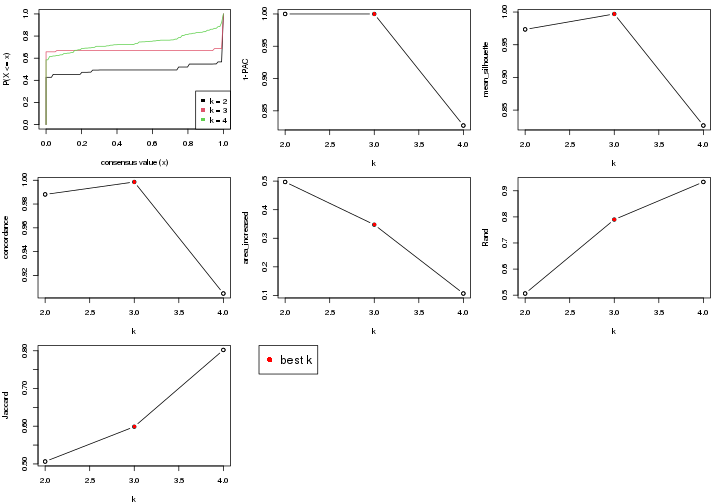
The numeric values for all these statistics can be obtained by get_stats().
get_stats(res)
#> k 1-PAC mean_silhouette concordance area_increased Rand Jaccard
#> 2 2 1.000 0.973 0.988 0.497 0.506 0.506
#> 3 3 1.000 0.997 0.999 0.347 0.790 0.599
#> 4 4 0.827 0.826 0.905 0.107 0.934 0.802
suggest_best_k() suggests the best \(k\) based on these statistics. The rules are as follows:
suggest_best_k(res)
#> [1] 3
#> attr(,"optional")
#> [1] 2
There is also optional best \(k\) = 2 that is worth to check.
Following is the table of the partitions (You need to click the show/hide
code output link to see it). The membership matrix (columns with name p*)
is inferred by
clue::cl_consensus()
function with the SE method. Basically the value in the membership matrix
represents the probability to belong to a certain group. The finall subgroup
label for an item is determined with the group with highest probability it
belongs to.
In get_classes() function, the entropy is calculated from the membership
matrix and the silhouette score is calculated from the consensus matrix.
cbind(get_classes(res, k = 2), get_membership(res, k = 2))
#> class entropy silhouette p1 p2
#> SRR1275356 1 0.000 0.981 1.00 0.00
#> SRR1275251 1 0.000 0.981 1.00 0.00
#> SRR1275287 2 0.000 0.997 0.00 1.00
#> SRR1275364 1 0.000 0.981 1.00 0.00
#> SRR1275263 1 0.000 0.981 1.00 0.00
#> SRR1275338 1 0.000 0.981 1.00 0.00
#> SRR1275299 2 0.000 0.997 0.00 1.00
#> SRR1275277 2 0.000 0.997 0.00 1.00
#> SRR1275370 1 0.000 0.981 1.00 0.00
#> SRR1275293 2 0.000 0.997 0.00 1.00
#> SRR1275348 2 0.242 0.957 0.04 0.96
#> SRR1275245 1 0.000 0.981 1.00 0.00
#> SRR1275342 1 0.000 0.981 1.00 0.00
#> SRR1275346 1 0.000 0.981 1.00 0.00
#> SRR1275279 2 0.000 0.997 0.00 1.00
#> SRR1275297 2 0.000 0.997 0.00 1.00
#> SRR1275273 2 0.000 0.997 0.00 1.00
#> SRR1275336 1 0.000 0.981 1.00 0.00
#> SRR1275267 2 0.000 0.997 0.00 1.00
#> SRR1275289 2 0.000 0.997 0.00 1.00
#> SRR1275360 1 0.000 0.981 1.00 0.00
#> SRR1275255 1 0.000 0.981 1.00 0.00
#> SRR1275358 1 0.000 0.981 1.00 0.00
#> SRR1275265 2 0.000 0.997 0.00 1.00
#> SRR1275368 1 0.000 0.981 1.00 0.00
#> SRR1275281 2 0.000 0.997 0.00 1.00
#> SRR1275257 1 0.000 0.981 1.00 0.00
#> SRR1275350 1 0.000 0.981 1.00 0.00
#> SRR1275334 1 0.827 0.661 0.74 0.26
#> SRR1275249 1 0.000 0.981 1.00 0.00
#> SRR1275243 1 0.000 0.981 1.00 0.00
#> SRR1275301 2 0.000 0.997 0.00 1.00
#> SRR1275295 2 0.000 0.997 0.00 1.00
#> SRR1275271 2 0.000 0.997 0.00 1.00
#> SRR1275247 2 0.000 0.997 0.00 1.00
#> SRR1275340 1 0.000 0.981 1.00 0.00
#> SRR1275354 1 0.722 0.755 0.80 0.20
#> SRR1275259 1 0.000 0.981 1.00 0.00
#> SRR1275253 1 0.000 0.981 1.00 0.00
#> SRR1275285 2 0.000 0.997 0.00 1.00
#> SRR1275366 1 0.000 0.981 1.00 0.00
#> SRR1275261 1 0.000 0.981 1.00 0.00
cbind(get_classes(res, k = 3), get_membership(res, k = 3))
#> class entropy silhouette p1 p2 p3
#> SRR1275356 1 0.000 0.996 1.00 0 0.00
#> SRR1275251 3 0.000 1.000 0.00 0 1.00
#> SRR1275287 2 0.000 1.000 0.00 1 0.00
#> SRR1275364 1 0.000 0.996 1.00 0 0.00
#> SRR1275263 3 0.000 1.000 0.00 0 1.00
#> SRR1275338 3 0.000 1.000 0.00 0 1.00
#> SRR1275299 2 0.000 1.000 0.00 1 0.00
#> SRR1275277 2 0.000 1.000 0.00 1 0.00
#> SRR1275370 1 0.000 0.996 1.00 0 0.00
#> SRR1275293 2 0.000 1.000 0.00 1 0.00
#> SRR1275348 1 0.000 0.996 1.00 0 0.00
#> SRR1275245 1 0.000 0.996 1.00 0 0.00
#> SRR1275342 3 0.000 1.000 0.00 0 1.00
#> SRR1275346 1 0.000 0.996 1.00 0 0.00
#> SRR1275279 2 0.000 1.000 0.00 1 0.00
#> SRR1275297 2 0.000 1.000 0.00 1 0.00
#> SRR1275273 2 0.000 1.000 0.00 1 0.00
#> SRR1275336 1 0.000 0.996 1.00 0 0.00
#> SRR1275267 2 0.000 1.000 0.00 1 0.00
#> SRR1275289 2 0.000 1.000 0.00 1 0.00
#> SRR1275360 1 0.000 0.996 1.00 0 0.00
#> SRR1275255 3 0.000 1.000 0.00 0 1.00
#> SRR1275358 3 0.000 1.000 0.00 0 1.00
#> SRR1275265 2 0.000 1.000 0.00 1 0.00
#> SRR1275368 1 0.000 0.996 1.00 0 0.00
#> SRR1275281 2 0.000 1.000 0.00 1 0.00
#> SRR1275257 1 0.000 0.996 1.00 0 0.00
#> SRR1275350 1 0.207 0.936 0.94 0 0.06
#> SRR1275334 1 0.000 0.996 1.00 0 0.00
#> SRR1275249 1 0.000 0.996 1.00 0 0.00
#> SRR1275243 1 0.000 0.996 1.00 0 0.00
#> SRR1275301 2 0.000 1.000 0.00 1 0.00
#> SRR1275295 2 0.000 1.000 0.00 1 0.00
#> SRR1275271 2 0.000 1.000 0.00 1 0.00
#> SRR1275247 2 0.000 1.000 0.00 1 0.00
#> SRR1275340 3 0.000 1.000 0.00 0 1.00
#> SRR1275354 1 0.000 0.996 1.00 0 0.00
#> SRR1275259 3 0.000 1.000 0.00 0 1.00
#> SRR1275253 1 0.000 0.996 1.00 0 0.00
#> SRR1275285 2 0.000 1.000 0.00 1 0.00
#> SRR1275366 3 0.000 1.000 0.00 0 1.00
#> SRR1275261 3 0.000 1.000 0.00 0 1.00
cbind(get_classes(res, k = 4), get_membership(res, k = 4))
#> class entropy silhouette p1 p2 p3 p4
#> SRR1275356 1 0.0000 0.906 1.00 0.00 0.00 0.00
#> SRR1275251 3 0.0000 1.000 0.00 0.00 1.00 0.00
#> SRR1275287 4 0.4713 0.383 0.00 0.36 0.00 0.64
#> SRR1275364 1 0.0707 0.890 0.98 0.00 0.02 0.00
#> SRR1275263 3 0.0000 1.000 0.00 0.00 1.00 0.00
#> SRR1275338 3 0.0000 1.000 0.00 0.00 1.00 0.00
#> SRR1275299 2 0.0707 0.872 0.00 0.98 0.00 0.02
#> SRR1275277 2 0.0000 0.870 0.00 1.00 0.00 0.00
#> SRR1275370 1 0.0000 0.906 1.00 0.00 0.00 0.00
#> SRR1275293 2 0.3610 0.810 0.00 0.80 0.00 0.20
#> SRR1275348 4 0.5077 0.695 0.16 0.08 0.00 0.76
#> SRR1275245 1 0.0000 0.906 1.00 0.00 0.00 0.00
#> SRR1275342 3 0.0000 1.000 0.00 0.00 1.00 0.00
#> SRR1275346 1 0.4994 -0.115 0.52 0.00 0.00 0.48
#> SRR1275279 2 0.0000 0.870 0.00 1.00 0.00 0.00
#> SRR1275297 2 0.2011 0.859 0.00 0.92 0.00 0.08
#> SRR1275273 2 0.4797 0.762 0.00 0.72 0.02 0.26
#> SRR1275336 1 0.0000 0.906 1.00 0.00 0.00 0.00
#> SRR1275267 2 0.6805 0.379 0.10 0.50 0.00 0.40
#> SRR1275289 2 0.1637 0.857 0.00 0.94 0.00 0.06
#> SRR1275360 1 0.0707 0.899 0.98 0.00 0.00 0.02
#> SRR1275255 3 0.0000 1.000 0.00 0.00 1.00 0.00
#> SRR1275358 3 0.0000 1.000 0.00 0.00 1.00 0.00
#> SRR1275265 2 0.4134 0.783 0.00 0.74 0.00 0.26
#> SRR1275368 1 0.3975 0.633 0.76 0.00 0.00 0.24
#> SRR1275281 2 0.0000 0.870 0.00 1.00 0.00 0.00
#> SRR1275257 1 0.2345 0.831 0.90 0.00 0.00 0.10
#> SRR1275350 4 0.6497 0.607 0.16 0.00 0.20 0.64
#> SRR1275334 1 0.1211 0.888 0.96 0.00 0.00 0.04
#> SRR1275249 1 0.0000 0.906 1.00 0.00 0.00 0.00
#> SRR1275243 4 0.4277 0.589 0.28 0.00 0.00 0.72
#> SRR1275301 2 0.3975 0.789 0.00 0.76 0.00 0.24
#> SRR1275295 2 0.0707 0.872 0.00 0.98 0.00 0.02
#> SRR1275271 2 0.0707 0.870 0.00 0.98 0.00 0.02
#> SRR1275247 2 0.3172 0.741 0.00 0.84 0.00 0.16
#> SRR1275340 3 0.0000 1.000 0.00 0.00 1.00 0.00
#> SRR1275354 1 0.0707 0.899 0.98 0.00 0.00 0.02
#> SRR1275259 3 0.0000 1.000 0.00 0.00 1.00 0.00
#> SRR1275253 1 0.0000 0.906 1.00 0.00 0.00 0.00
#> SRR1275285 2 0.0000 0.870 0.00 1.00 0.00 0.00
#> SRR1275366 3 0.0000 1.000 0.00 0.00 1.00 0.00
#> SRR1275261 3 0.0000 1.000 0.00 0.00 1.00 0.00
Heatmaps for the consensus matrix. It visualizes the probability of two samples to be in a same group.
consensus_heatmap(res, k = 2)
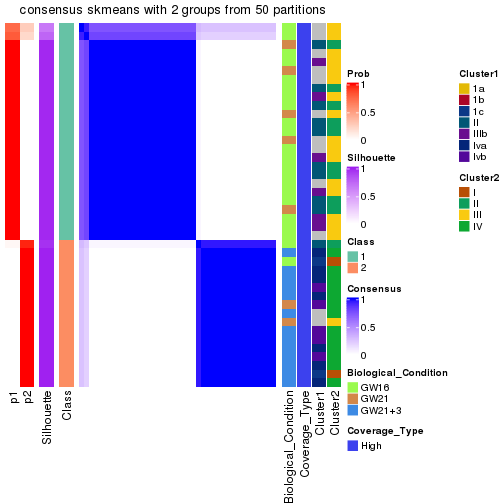
consensus_heatmap(res, k = 3)
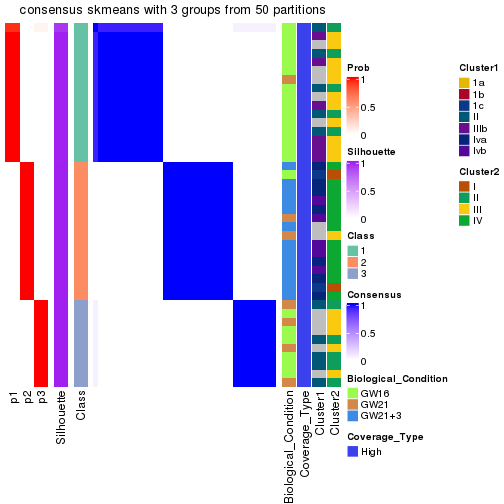
consensus_heatmap(res, k = 4)
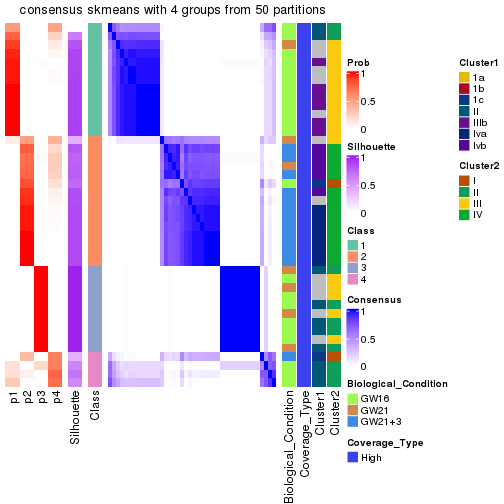
Heatmaps for the membership of samples in all partitions to see how consistent they are:
membership_heatmap(res, k = 2)
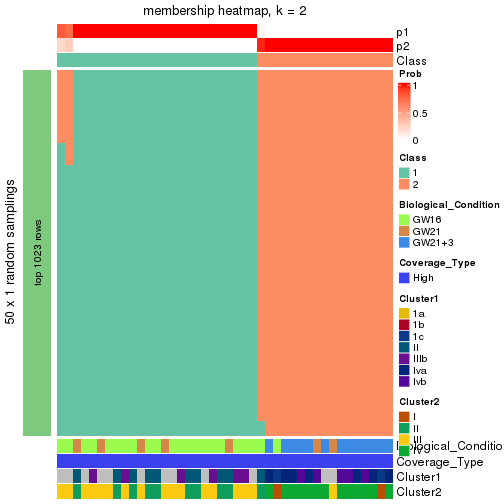
membership_heatmap(res, k = 3)
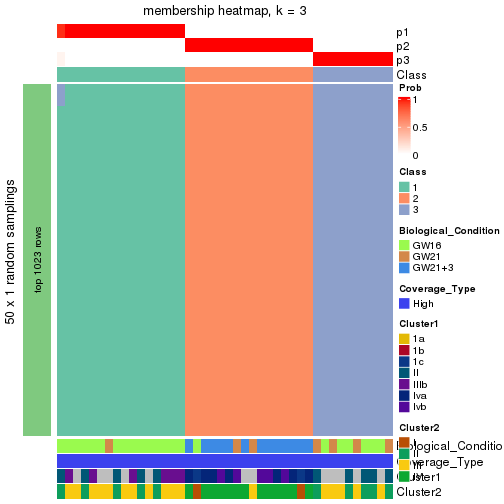
membership_heatmap(res, k = 4)

As soon as the classes for columns are determined, the signatures that are significantly different between subgroups can be looked for. Following are the heatmaps for signatures.
Signature heatmaps where rows are scaled:
Signature heatmaps where rows are not scaled:
get_signatures(res, k = 2, scale_rows = FALSE)
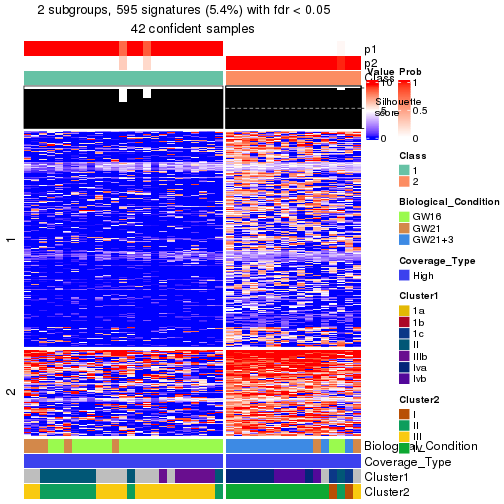
get_signatures(res, k = 3, scale_rows = FALSE)
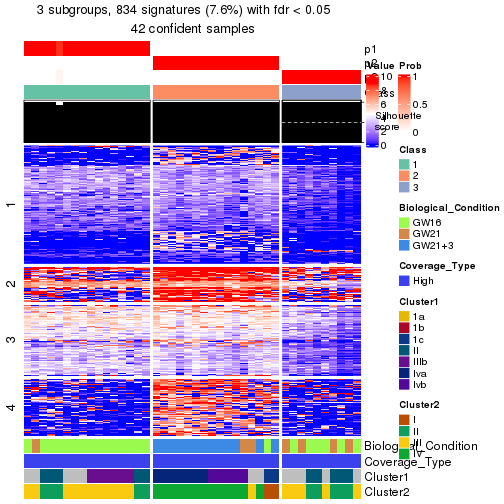
get_signatures(res, k = 4, scale_rows = FALSE)
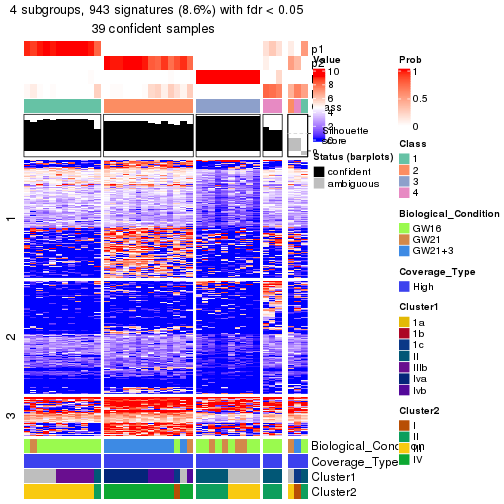
Compare the overlap of signatures from different k:
compare_signatures(res)
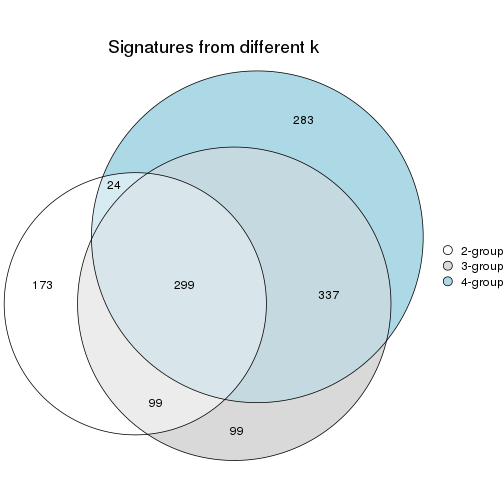
get_signature() returns a data frame invisibly. To get the list of signatures, the function
call should be assigned to a variable explicitly. In following code, if plot argument is set
to FALSE, no heatmap is plotted while only the differential analysis is performed.
# code only for demonstration
tb = get_signature(res, k = ..., plot = FALSE)
An example of the output of tb is:
#> which_row fdr mean_1 mean_2 scaled_mean_1 scaled_mean_2 km
#> 1 38 0.042760348 8.373488 9.131774 -0.5533452 0.5164555 1
#> 2 40 0.018707592 7.106213 8.469186 -0.6173731 0.5762149 1
#> 3 55 0.019134737 10.221463 11.207825 -0.6159697 0.5749050 1
#> 4 59 0.006059896 5.921854 7.869574 -0.6899429 0.6439467 1
#> 5 60 0.018055526 8.928898 10.211722 -0.6204761 0.5791110 1
#> 6 98 0.009384629 15.714769 14.887706 0.6635654 -0.6193277 2
...
The columns in tb are:
which_row: row indices corresponding to the input matrix.fdr: FDR for the differential test. mean_x: The mean value in group x.scaled_mean_x: The mean value in group x after rows are scaled.km: Row groups if k-means clustering is applied to rows (which is done by automatically selecting number of clusters).If there are too many signatures, top_signatures = ... can be set to only show the
signatures with the highest FDRs:
# code only for demonstration
# e.g. to show the top 500 most significant rows
tb = get_signature(res, k = ..., top_signatures = 500)
If the signatures are defined as these which are uniquely high in current group, diff_method argument
can be set to "uniquely_high_in_one_group":
# code only for demonstration
tb = get_signature(res, k = ..., diff_method = "uniquely_high_in_one_group")
UMAP plot which shows how samples are separated.
dimension_reduction(res, k = 2, method = "UMAP")
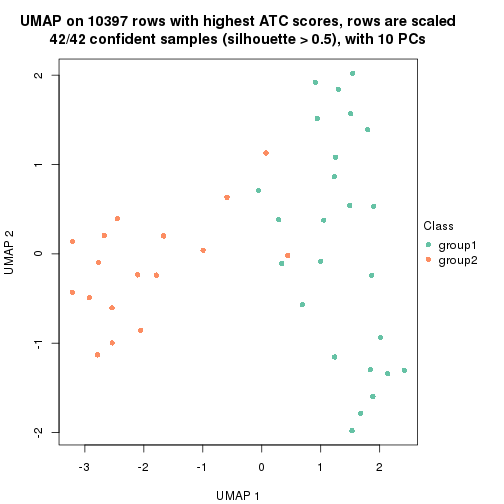
dimension_reduction(res, k = 3, method = "UMAP")
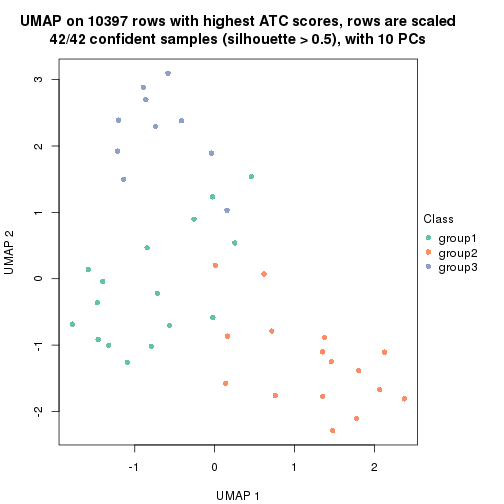
dimension_reduction(res, k = 4, method = "UMAP")

Following heatmap shows how subgroups are split when increasing k:
collect_classes(res)
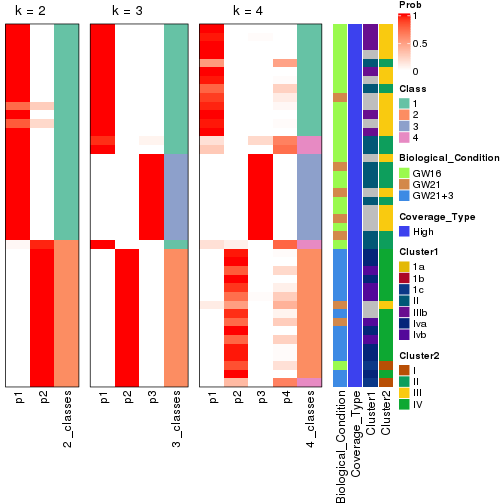
Test correlation between subgroups and known annotations. If the known annotation is numeric, one-way ANOVA test is applied, and if the known annotation is discrete, chi-squared contingency table test is applied.
test_to_known_factors(res)
#> n_sample Biological_Condition(p-value) Coverage_Type(p-value) Cluster1(p-value)
#> ATC:skmeans 42 6.40e-07 NA 2.63e-05
#> ATC:skmeans 42 1.46e-07 NA 6.97e-06
#> ATC:skmeans 39 1.80e-06 NA 1.83e-06
#> Cluster2(p-value) k
#> ATC:skmeans 1.66e-07 2
#> ATC:skmeans 5.84e-07 3
#> ATC:skmeans 1.29e-08 4
If matrix rows can be associated to genes, consider to use functional_enrichment(res,
...) to perform function enrichment for the signature genes. See this vignette for more detailed explanations.
Parent node: Node0. Child nodes: Node011-leaf , Node012-leaf , Node013-leaf , Node021-leaf , Node022-leaf .
The object with results only for a single top-value method and a single partitioning method can be extracted as:
res = res_rh["02"]
A summary of res and all the functions that can be applied to it:
res
#> A 'ConsensusPartition' object with k = 2, 3, 4.
#> On a matrix with 10445 rows and 23 columns.
#> Top rows (1044) are extracted by 'ATC' method.
#> Subgroups are detected by 'skmeans' method.
#> Performed in total 150 partitions by row resampling.
#> Best k for subgroups seems to be 2.
#>
#> Following methods can be applied to this 'ConsensusPartition' object:
#> [1] "cola_report" "collect_classes" "collect_plots"
#> [4] "collect_stats" "colnames" "compare_partitions"
#> [7] "compare_signatures" "consensus_heatmap" "dimension_reduction"
#> [10] "functional_enrichment" "get_anno_col" "get_anno"
#> [13] "get_classes" "get_consensus" "get_matrix"
#> [16] "get_membership" "get_param" "get_signatures"
#> [19] "get_stats" "is_best_k" "is_stable_k"
#> [22] "membership_heatmap" "ncol" "nrow"
#> [25] "plot_ecdf" "predict_classes" "rownames"
#> [28] "select_partition_number" "show" "suggest_best_k"
#> [31] "test_to_known_factors" "top_rows_heatmap"
collect_plots() function collects all the plots made from res for all k (number of subgroups)
into one single page to provide an easy and fast comparison between different k.
collect_plots(res)

The plots are:
k and the heatmap of
predicted classes for each k.k.k.k.All the plots in panels can be made by individual functions and they are plotted later in this section.
select_partition_number() produces several plots showing different
statistics for choosing “optimized” k. There are following statistics:
k;k, the area increased is defined as \(A_k - A_{k-1}\).The detailed explanations of these statistics can be found in the cola vignette.
Generally speaking, higher 1-PAC score, higher mean silhouette score or higher
concordance corresponds to better partition. Rand index and Jaccard index
measure how similar the current partition is compared to partition with k-1.
If they are too similar, we won't accept k is better than k-1.
select_partition_number(res)
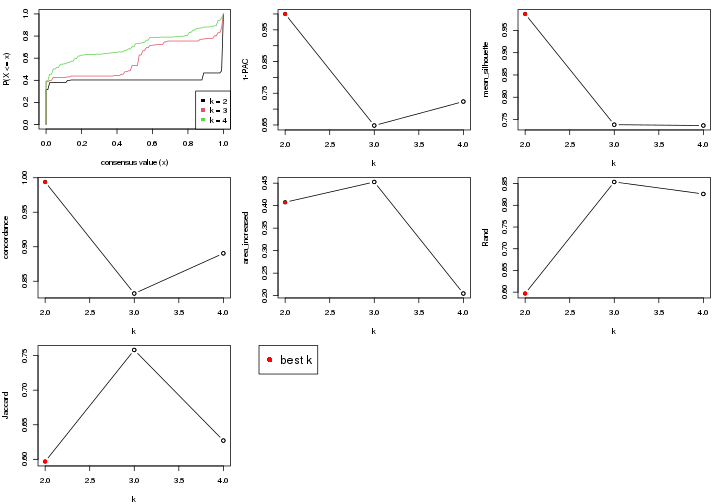
The numeric values for all these statistics can be obtained by get_stats().
get_stats(res)
#> k 1-PAC mean_silhouette concordance area_increased Rand Jaccard
#> 2 2 1.000 0.987 0.994 0.408 0.597 0.597
#> 3 3 0.648 0.738 0.832 0.453 0.854 0.758
#> 4 4 0.724 0.736 0.890 0.205 0.826 0.627
suggest_best_k() suggests the best \(k\) based on these statistics. The rules are as follows:
suggest_best_k(res)
#> [1] 2
Following is the table of the partitions (You need to click the show/hide
code output link to see it). The membership matrix (columns with name p*)
is inferred by
clue::cl_consensus()
function with the SE method. Basically the value in the membership matrix
represents the probability to belong to a certain group. The finall subgroup
label for an item is determined with the group with highest probability it
belongs to.
In get_classes() function, the entropy is calculated from the membership
matrix and the silhouette score is calculated from the consensus matrix.
cbind(get_classes(res, k = 2), get_membership(res, k = 2))
#> class entropy silhouette p1 p2
#> SRR1275269 1 0.529 0.863 0.88 0.12
#> SRR1274117 1 0.000 0.992 1.00 0.00
#> SRR1274089 1 0.000 0.992 1.00 0.00
#> SRR1274125 1 0.000 0.992 1.00 0.00
#> SRR1274131 1 0.000 0.992 1.00 0.00
#> SRR1275241 1 0.000 0.992 1.00 0.00
#> SRR1274121 1 0.000 0.992 1.00 0.00
#> SRR1274119 1 0.000 0.992 1.00 0.00
#> SRR1274087 1 0.000 0.992 1.00 0.00
#> SRR1274113 1 0.000 0.992 1.00 0.00
#> SRR1275283 2 0.000 0.996 0.00 1.00
#> SRR1275352 2 0.000 0.996 0.00 1.00
#> SRR1275362 2 0.141 0.979 0.02 0.98
#> SRR1274129 1 0.000 0.992 1.00 0.00
#> SRR1274123 1 0.000 0.992 1.00 0.00
#> SRR1274085 1 0.000 0.992 1.00 0.00
#> SRR1274111 1 0.000 0.992 1.00 0.00
#> SRR1275344 2 0.000 0.996 0.00 1.00
#> SRR1274133 1 0.000 0.992 1.00 0.00
#> SRR1275275 2 0.000 0.996 0.00 1.00
#> SRR1275291 2 0.000 0.996 0.00 1.00
#> SRR1274115 1 0.000 0.992 1.00 0.00
#> SRR1274127 1 0.000 0.992 1.00 0.00
cbind(get_classes(res, k = 3), get_membership(res, k = 3))
#> class entropy silhouette p1 p2 p3
#> SRR1275269 3 0.0000 0.968 0.00 0.00 1.00
#> SRR1274117 1 0.0000 0.628 1.00 0.00 0.00
#> SRR1274089 1 0.6302 0.583 0.52 0.00 0.48
#> SRR1274125 1 0.0000 0.628 1.00 0.00 0.00
#> SRR1274131 1 0.3686 0.636 0.86 0.00 0.14
#> SRR1275241 3 0.0000 0.968 0.00 0.00 1.00
#> SRR1274121 1 0.0000 0.628 1.00 0.00 0.00
#> SRR1274119 1 0.6302 0.583 0.52 0.00 0.48
#> SRR1274087 1 0.6302 0.583 0.52 0.00 0.48
#> SRR1274113 1 0.6280 0.592 0.54 0.00 0.46
#> SRR1275283 2 0.0000 1.000 0.00 1.00 0.00
#> SRR1275352 2 0.0000 1.000 0.00 1.00 0.00
#> SRR1275362 3 0.1529 0.938 0.00 0.04 0.96
#> SRR1274129 1 0.6302 0.583 0.52 0.00 0.48
#> SRR1274123 1 0.6302 0.583 0.52 0.00 0.48
#> SRR1274085 1 0.0000 0.628 1.00 0.00 0.00
#> SRR1274111 1 0.6192 0.601 0.58 0.00 0.42
#> SRR1275344 2 0.0000 1.000 0.00 1.00 0.00
#> SRR1274133 1 0.0892 0.634 0.98 0.00 0.02
#> SRR1275275 2 0.0000 1.000 0.00 1.00 0.00
#> SRR1275291 2 0.0000 1.000 0.00 1.00 0.00
#> SRR1274115 1 0.1529 0.638 0.96 0.00 0.04
#> SRR1274127 1 0.6302 0.583 0.52 0.00 0.48
cbind(get_classes(res, k = 4), get_membership(res, k = 4))
#> class entropy silhouette p1 p2 p3 p4
#> SRR1275269 3 0.1637 0.9079 0.06 0.00 0.94 0.00
#> SRR1274117 4 0.0000 0.6959 0.00 0.00 0.00 1.00
#> SRR1274089 1 0.0707 0.8329 0.98 0.00 0.02 0.00
#> SRR1274125 4 0.0707 0.7082 0.02 0.00 0.00 0.98
#> SRR1274131 1 0.3821 0.7332 0.84 0.00 0.04 0.12
#> SRR1275241 3 0.2921 0.8660 0.14 0.00 0.86 0.00
#> SRR1274121 4 0.4284 0.6765 0.20 0.00 0.02 0.78
#> SRR1274119 1 0.0707 0.8329 0.98 0.00 0.02 0.00
#> SRR1274087 1 0.0707 0.8329 0.98 0.00 0.02 0.00
#> SRR1274113 1 0.0707 0.8245 0.98 0.00 0.00 0.02
#> SRR1275283 2 0.0000 0.9539 0.00 1.00 0.00 0.00
#> SRR1275352 2 0.1211 0.9411 0.00 0.96 0.04 0.00
#> SRR1275362 3 0.0707 0.8800 0.02 0.00 0.98 0.00
#> SRR1274129 1 0.0707 0.8243 0.98 0.00 0.00 0.02
#> SRR1274123 1 0.0707 0.8329 0.98 0.00 0.02 0.00
#> SRR1274085 4 0.4948 0.1388 0.44 0.00 0.00 0.56
#> SRR1274111 1 0.3400 0.6789 0.82 0.00 0.00 0.18
#> SRR1275344 2 0.3172 0.8424 0.00 0.84 0.16 0.00
#> SRR1274133 1 0.5000 -0.0796 0.50 0.00 0.00 0.50
#> SRR1275275 2 0.0000 0.9539 0.00 1.00 0.00 0.00
#> SRR1275291 2 0.0000 0.9539 0.00 1.00 0.00 0.00
#> SRR1274115 1 0.5860 0.2797 0.58 0.00 0.04 0.38
#> SRR1274127 1 0.1411 0.8280 0.96 0.00 0.02 0.02
Heatmaps for the consensus matrix. It visualizes the probability of two samples to be in a same group.
consensus_heatmap(res, k = 2)
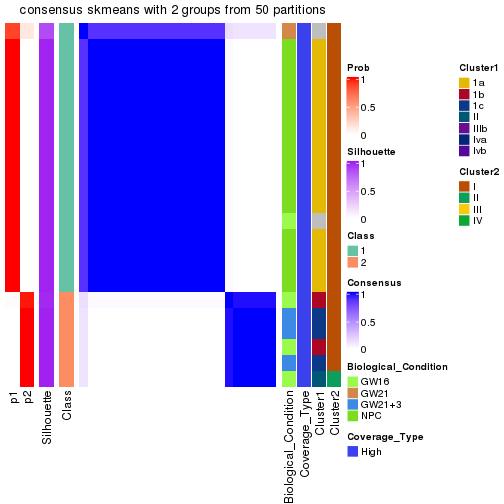
consensus_heatmap(res, k = 3)
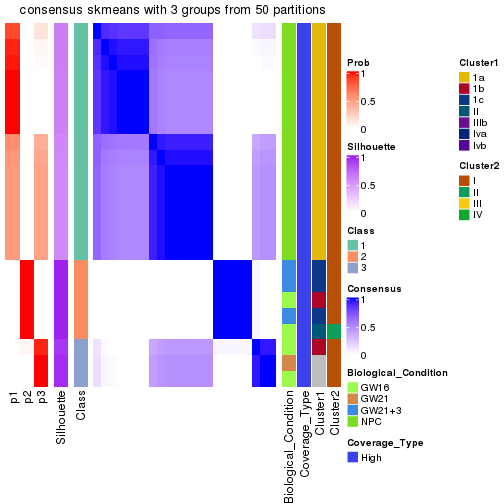
consensus_heatmap(res, k = 4)
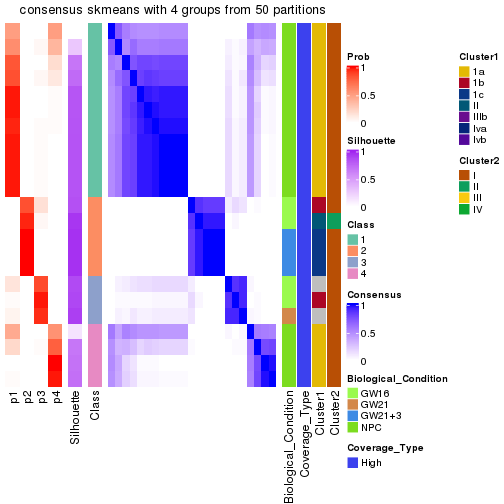
Heatmaps for the membership of samples in all partitions to see how consistent they are:
membership_heatmap(res, k = 2)
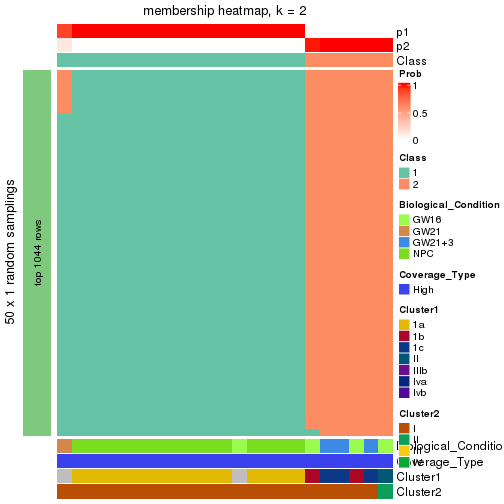
membership_heatmap(res, k = 3)
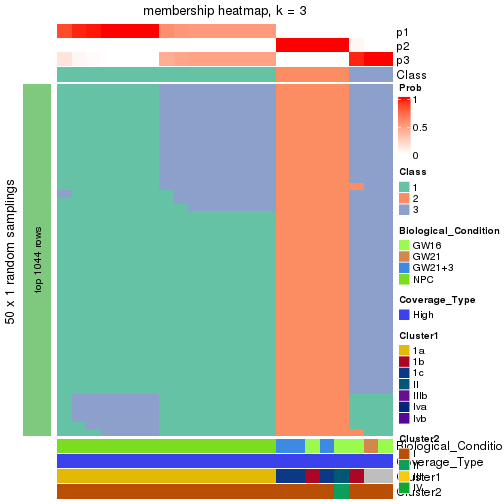
membership_heatmap(res, k = 4)
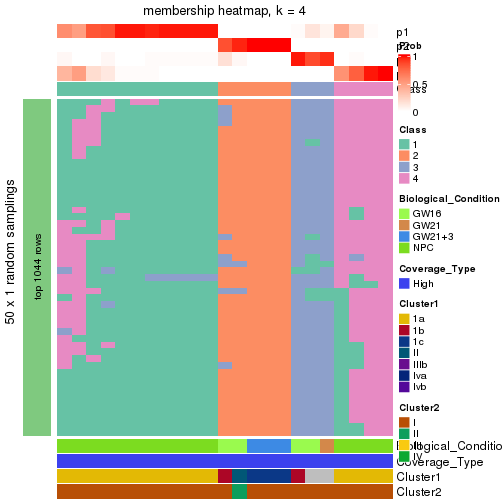
As soon as the classes for columns are determined, the signatures that are significantly different between subgroups can be looked for. Following are the heatmaps for signatures.
Signature heatmaps where rows are scaled:
Signature heatmaps where rows are not scaled:
get_signatures(res, k = 2, scale_rows = FALSE)
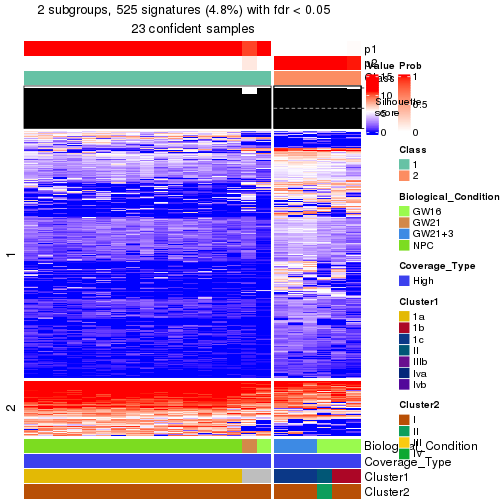
get_signatures(res, k = 3, scale_rows = FALSE)
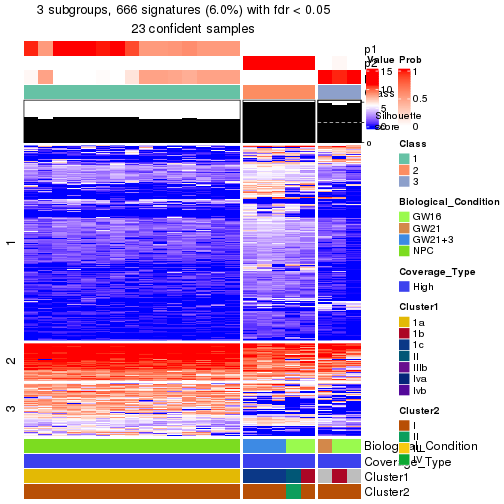
get_signatures(res, k = 4, scale_rows = FALSE)
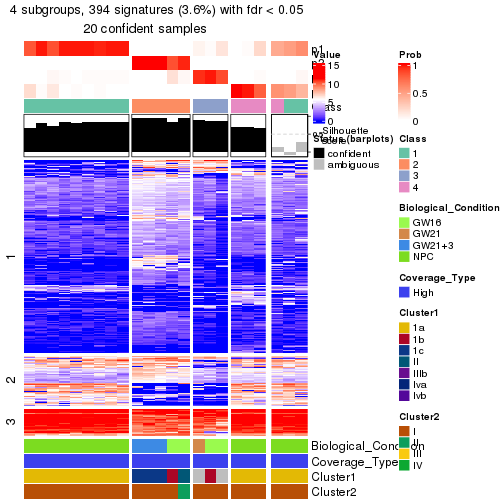
Compare the overlap of signatures from different k:
compare_signatures(res)
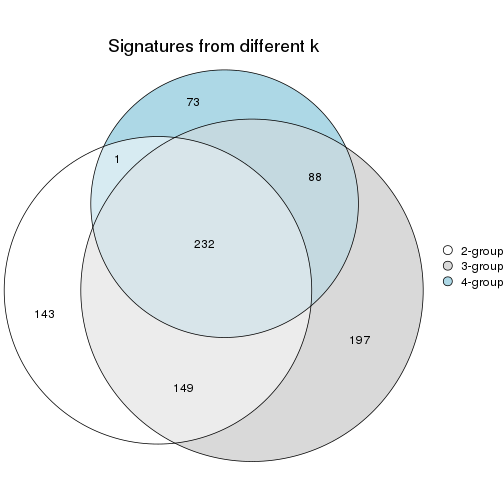
get_signature() returns a data frame invisibly. To get the list of signatures, the function
call should be assigned to a variable explicitly. In following code, if plot argument is set
to FALSE, no heatmap is plotted while only the differential analysis is performed.
# code only for demonstration
tb = get_signature(res, k = ..., plot = FALSE)
An example of the output of tb is:
#> which_row fdr mean_1 mean_2 scaled_mean_1 scaled_mean_2 km
#> 1 38 0.042760348 8.373488 9.131774 -0.5533452 0.5164555 1
#> 2 40 0.018707592 7.106213 8.469186 -0.6173731 0.5762149 1
#> 3 55 0.019134737 10.221463 11.207825 -0.6159697 0.5749050 1
#> 4 59 0.006059896 5.921854 7.869574 -0.6899429 0.6439467 1
#> 5 60 0.018055526 8.928898 10.211722 -0.6204761 0.5791110 1
#> 6 98 0.009384629 15.714769 14.887706 0.6635654 -0.6193277 2
...
The columns in tb are:
which_row: row indices corresponding to the input matrix.fdr: FDR for the differential test. mean_x: The mean value in group x.scaled_mean_x: The mean value in group x after rows are scaled.km: Row groups if k-means clustering is applied to rows (which is done by automatically selecting number of clusters).If there are too many signatures, top_signatures = ... can be set to only show the
signatures with the highest FDRs:
# code only for demonstration
# e.g. to show the top 500 most significant rows
tb = get_signature(res, k = ..., top_signatures = 500)
If the signatures are defined as these which are uniquely high in current group, diff_method argument
can be set to "uniquely_high_in_one_group":
# code only for demonstration
tb = get_signature(res, k = ..., diff_method = "uniquely_high_in_one_group")
UMAP plot which shows how samples are separated.
dimension_reduction(res, k = 2, method = "UMAP")
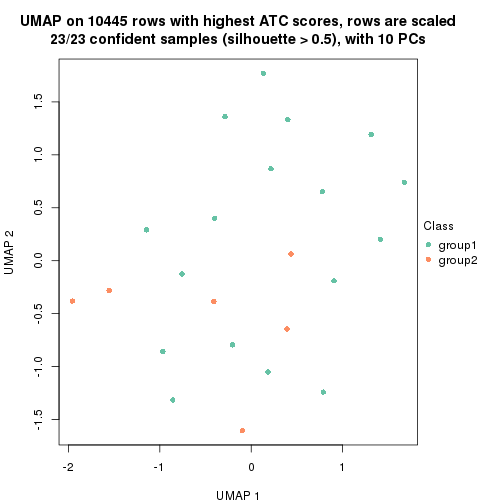
dimension_reduction(res, k = 3, method = "UMAP")
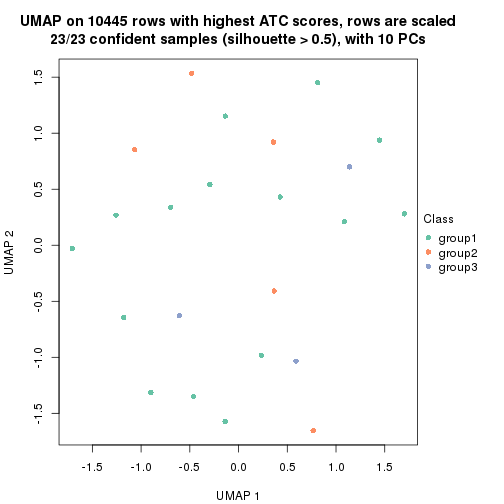
dimension_reduction(res, k = 4, method = "UMAP")
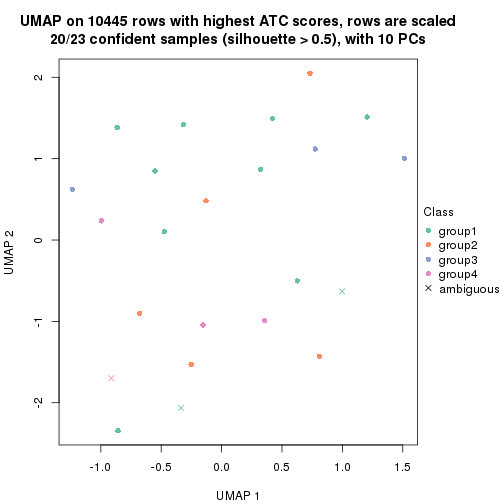
Following heatmap shows how subgroups are split when increasing k:
collect_classes(res)

Test correlation between subgroups and known annotations. If the known annotation is numeric, one-way ANOVA test is applied, and if the known annotation is discrete, chi-squared contingency table test is applied.
test_to_known_factors(res)
#> n_sample Biological_Condition(p-value) Coverage_Type(p-value) Cluster1(p-value)
#> ATC:skmeans 23 2.59e-04 NA 1.05e-04
#> ATC:skmeans 23 7.57e-06 NA 5.11e-05
#> ATC:skmeans 20 5.69e-04 NA 2.76e-03
#> Cluster2(p-value) k
#> ATC:skmeans 0.578 2
#> ATC:skmeans 0.152 3
#> ATC:skmeans 0.368 4
If matrix rows can be associated to genes, consider to use functional_enrichment(res,
...) to perform function enrichment for the signature genes. See this vignette for more detailed explanations.
sessionInfo()
#> R version 4.1.0 (2021-05-18)
#> Platform: x86_64-pc-linux-gnu (64-bit)
#> Running under: CentOS Linux 7 (Core)
#>
#> Matrix products: default
#> BLAS/LAPACK: /usr/lib64/libopenblas-r0.3.3.so
#>
#> locale:
#> [1] LC_CTYPE=en_US.UTF-8 LC_NUMERIC=C LC_TIME=en_US.UTF-8
#> [4] LC_COLLATE=en_US.UTF-8 LC_MONETARY=en_US.UTF-8 LC_MESSAGES=en_US.UTF-8
#> [7] LC_PAPER=en_US.UTF-8 LC_NAME=C LC_ADDRESS=C
#> [10] LC_TELEPHONE=C LC_MEASUREMENT=en_US.UTF-8 LC_IDENTIFICATION=C
#>
#> attached base packages:
#> [1] grid parallel stats4 stats graphics grDevices utils datasets methods
#> [10] base
#>
#> other attached packages:
#> [1] genefilter_1.74.0 ComplexHeatmap_2.8.0 markdown_1.1
#> [4] knitr_1.33 scRNAseq_2.6.1 SingleCellExperiment_1.14.1
#> [7] SummarizedExperiment_1.22.0 Biobase_2.52.0 GenomicRanges_1.44.0
#> [10] GenomeInfoDb_1.28.1 IRanges_2.26.0 S4Vectors_0.30.0
#> [13] BiocGenerics_0.38.0 MatrixGenerics_1.4.0 matrixStats_0.59.0
#> [16] cola_1.9.4
#>
#> loaded via a namespace (and not attached):
#> [1] circlize_0.4.13 AnnotationHub_3.0.1 BiocFileCache_2.0.0
#> [4] lazyeval_0.2.2 polylabelr_0.2.0 splines_4.1.0
#> [7] Polychrome_1.3.1 BiocParallel_1.26.1 ggplot2_3.3.5
#> [10] digest_0.6.27 foreach_1.5.1 ensembldb_2.16.3
#> [13] htmltools_0.5.1.1 viridis_0.6.1 fansi_0.5.0
#> [16] magrittr_2.0.1 memoise_2.0.0 cluster_2.1.2
#> [19] doParallel_1.0.16 Biostrings_2.60.1 annotate_1.70.0
#> [22] askpass_1.1 prettyunits_1.1.1 colorspace_2.0-2
#> [25] blob_1.2.1 rappdirs_0.3.3 xfun_0.24
#> [28] dplyr_1.0.7 crayon_1.4.1 RCurl_1.98-1.3
#> [31] microbenchmark_1.4-7 jsonlite_1.7.2 impute_1.66.0
#> [34] brew_1.0-6 survival_3.2-11 iterators_1.0.13
#> [37] glue_1.4.2 polyclip_1.10-0 gtable_0.3.0
#> [40] zlibbioc_1.38.0 XVector_0.32.0 GetoptLong_1.0.5
#> [43] DelayedArray_0.18.0 shape_1.4.6 scales_1.1.1
#> [46] data.tree_1.0.0 DBI_1.1.1 Rcpp_1.0.7
#> [49] viridisLite_0.4.0 xtable_1.8-4 progress_1.2.2
#> [52] clue_0.3-59 reticulate_1.20 bit_4.0.4
#> [55] mclust_5.4.7 umap_0.2.7.0 httr_1.4.2
#> [58] RColorBrewer_1.1-2 ellipsis_0.3.2 pkgconfig_2.0.3
#> [61] XML_3.99-0.6 dbplyr_2.1.1 utf8_1.2.1
#> [64] tidyselect_1.1.1 rlang_0.4.11 later_1.2.0
#> [67] AnnotationDbi_1.54.1 munsell_0.5.0 BiocVersion_3.13.1
#> [70] tools_4.1.0 cachem_1.0.5 generics_0.1.0
#> [73] RSQLite_2.2.7 ExperimentHub_2.0.0 evaluate_0.14
#> [76] stringr_1.4.0 fastmap_1.1.0 yaml_2.2.1
#> [79] bit64_4.0.5 purrr_0.3.4 dendextend_1.15.1
#> [82] KEGGREST_1.32.0 AnnotationFilter_1.16.0 mime_0.11
#> [85] slam_0.1-48 xml2_1.3.2 biomaRt_2.48.2
#> [88] compiler_4.1.0 rstudioapi_0.13 filelock_1.0.2
#> [91] curl_4.3.2 png_0.1-7 interactiveDisplayBase_1.30.0
#> [94] tibble_3.1.2 stringi_1.7.3 highr_0.9
#> [97] GenomicFeatures_1.44.0 RSpectra_0.16-0 lattice_0.20-44
#> [100] ProtGenerics_1.24.0 Matrix_1.3-4 vctrs_0.3.8
#> [103] pillar_1.6.1 lifecycle_1.0.0 BiocManager_1.30.16
#> [106] eulerr_6.1.0 GlobalOptions_0.1.2 bitops_1.0-7
#> [109] irlba_2.3.3 httpuv_1.6.1 rtracklayer_1.52.0
#> [112] R6_2.5.0 BiocIO_1.2.0 promises_1.2.0.1
#> [115] gridExtra_2.3 codetools_0.2-18 assertthat_0.2.1
#> [118] openssl_1.4.4 rjson_0.2.20 GenomicAlignments_1.28.0
#> [121] Rsamtools_2.8.0 GenomeInfoDbData_1.2.6 hms_1.1.0
#> [124] skmeans_0.2-13 Cairo_1.5-12.2 scatterplot3d_0.3-41
#> [127] shiny_1.6.0 restfulr_0.0.13